- 1Docker-13:Docker安装Hbase
- 2关于快速排序算法的学习心得_排序实验实训总结
- 3OceanBase 分布式数据库【信创/国产化】- OceanBase 数据库整体架构
- 4RK3588 & Android12 调试 RTL8852BE(wifi篇)_rk8852be
- 5VHDL实现数字频率计的设计_数字频率计设计vhdl
- 6基于SSM的文化遗产的保护与旅游开发系统(有报告)。Javaee项目。ssm项目。
- 7讲真,做Python一定不要只会一个方向!
- 8PC电脑 VMware安装的linux CentOs7如何扩容磁盘?_linux虚拟机安装好之后还能设置磁盘大小码
- 9机器学习介绍_setlabelcol
- 10Cesium 核心概念 核心接口_cesuim可以实现的功能
python数据分析与量化交易_python量化交易
赞
踩
第一章-学习之前的认知
影响股价的因素
1、公司自身因素
2、心理因素
3、行业因素
4、经济因素
5、市场因素
6、政治因素
- 1
- 2
- 3
- 4
- 5
- 6
金融量化投资
量化投资的优势
1、避免主观情绪,人性弱点和认知偏差,选择更加客观
2、能同时包括多角度的观察和多层次的模型
3、及时跟踪市场变化,不断发现新的统计模型,寻找交易机会
4、在决定投资策略后,能通过回测验证其效果
量化策略
通过一套固定的逻辑来分析、判断和决策,自动地进行股票交易
策略的周期
实现想法、学习知识
实现策略:python
检验策略:回测、模拟交易
实盘交易
优化策略,放弃策略
- 1
- 2
- 3
- 4
- 5
- 6
- 7
- 8
- 9
- 10
- 11
- 12
- 13

第二章-科学计算基础包—numpy
量化投资和python
为什么选择python呢?
其他选择:excel、SAS/SPSS(统计软件,无编程)、R(功能太单一,制作数据分析)
量化投资实际上就是分析数据从而做出决策的过程
python数据处理相关模块
1、NumPy:数组批量计算
2、pandas:灵活的表计算
3、Matplotlib:数据可视化
- 1
- 2
- 3
- 4
- 5
- 6
- 7
怎么使用python进行量化投资
自己编写
NumPy \+ pandas + Matplotlib....
在线平台
聚宽、优矿、米筐、Quantopian....
开源框架
RQAlpha、QUANTAXIS....
- 1
- 2
- 3
- 4
- 5
- 6
IPython的使用
pip3 install ipthon
也可以直接安装anacoda ,集成了ipython、NumPy pandas Matplotlib 等许多python的常用模块和框架
- 1
- 2
与python解释器的使用方法一致


TAB键自动完成

?内省、查看具体信息
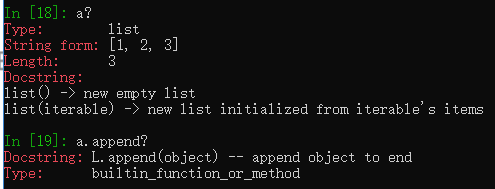
?进行模糊匹配,命名空间搜索

!执行系统命令

某些命令不用加也能执行

??两个问号
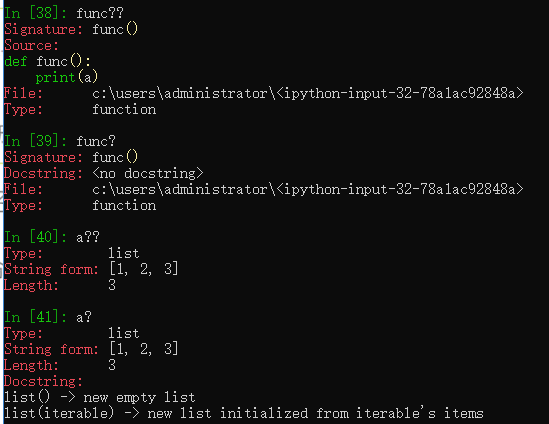
快捷键
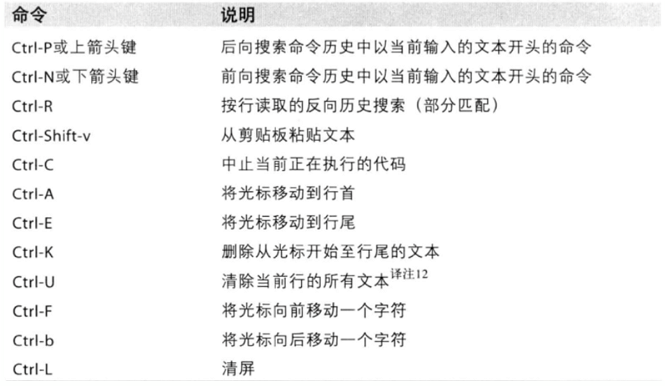
IPython的魔术命令

%timeit 很费事,他要跑很多次

%paste 执行剪切板中的python代码
%pdb 在异常发生后自动进入调试模式,使用on

然后就可以使用pdb相关的命令,进行调试状态
p命令最常用,打印的意思

%魔术命令
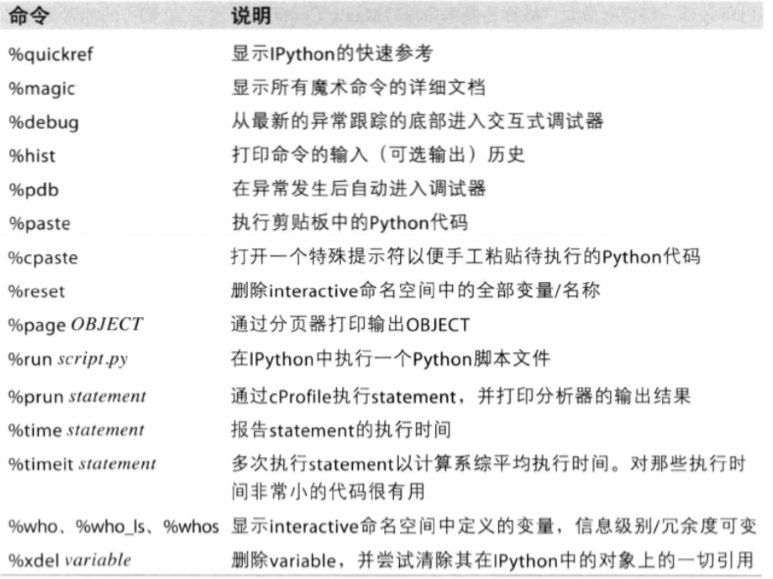

命令的历史可以使用上下方向键,或者%hist查看命令历史
_ 表示上一次的输出
__ 表示上两个命令
_48 第多少的结果
_i48 第多少行的结果的字符串形式
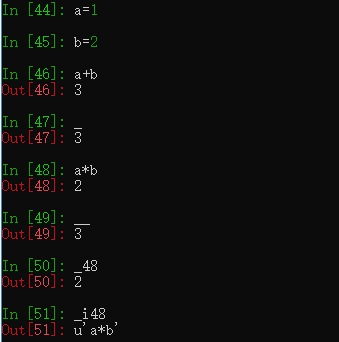
%bookmark 目录标签系统

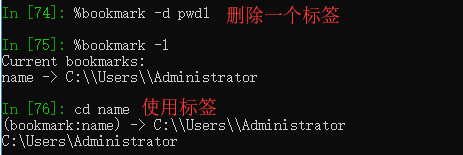

IPython Notebook-Jupyter的初识
安装jupyter

使用notebook

进入了jupyter的web界面

创建新的notebook

出现一个小问题:编写的代码不能运行且前面的提示符In[*]
查看命令行,出现错误提示

将软件降级安装后,解决问题

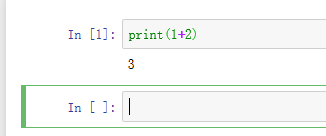
可以用notebook写博客,支持makedown,而且他可以将页面直接输出成很多文本形式
正戏-Numpy模块
Numpy简介
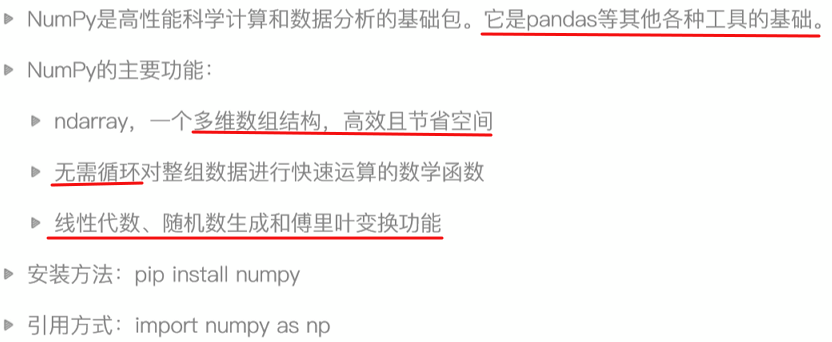
实例展示为什么要使用numpy
例子:已知若干家跨国公司的市值,将其换算成人民币
普通的函数方法
1、将公司市值存储成列表或者其他格式
2、创建变量,存储汇率
2、遍历列表
3、做乘法运算,放入新的列表
- 1
- 2
- 3
- 4
用numpy



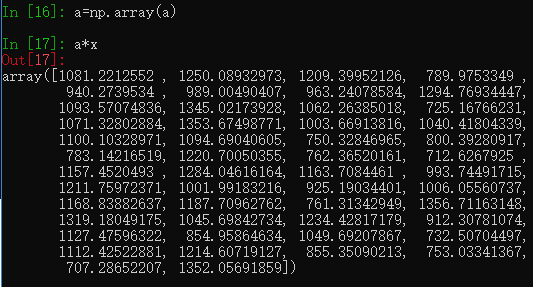
例子2:已知每件商品的价格和每件商品的数量,计算总金额
还是用a作为价格,再创建一个数组作为每件商品的数量


计算每件商品的价格
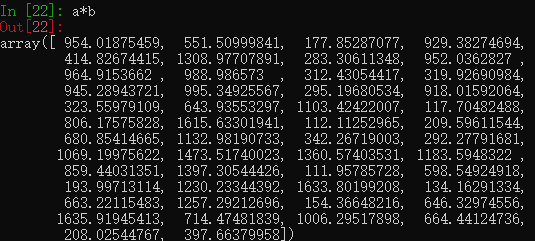
计算总金额

ndarray-多维数组对象

ndarray-常用属性

In \[26\]: a.ndim Out\[26\]: 1 In \[27\]: a.size Out\[27\]: 50 In \[28\]: a.shape Out\[28\]: (50,) \----------------------------- In \[30\]: b = np.array(\[\[1,2,3,\],\[4,5,6\]\]) In \[31\]: b.ndim Out\[31\]: 2 In \[32\]: b.size Out\[32\]: 6 In \[33\]: b.shape Out\[33\]: (2, 3) \----------------------------- 三维-第三个维度相当于笔记本的每一页,翻个页就到另一面 In \[35\]: c = np.array(\[\[\[1,2,3,\],\[4,5,6\]\],\[\[1,2,3\],\[1,2,3\]\]\]) In \[36\]: c Out\[36\]: array(\[\[\[1, 2, 3\], \[4, 5, 6\]\], \[\[1, 2, 3\], \[1, 2, 3\]\]\]) In \[37\]: c.shape Out\[37\]: (2, 2, 3) \------------------------------------ 数组的转置 In \[39\]: c = c.T In \[40\]: c Out\[40\]: array(\[\[\[1, 1\], \[4, 1\]\], \[\[2, 2\], \[5, 2\]\], \[\[3, 3\], \[6, 3\]\]\]) In \[41\]: c = c.T In \[42\]: c Out\[42\]: array(\[\[\[1, 2, 3\], \[4, 5, 6\]\], \[\[1, 2, 3\], \[1, 2, 3\]\]\])
- 1
- 2
- 3
- 4
- 5
- 6
- 7
- 8
- 9
- 10
- 11
- 12
- 13
- 14
- 15
- 16
- 17
- 18
- 19
- 20
- 21
- 22
- 23
- 24
- 25
- 26
- 27
- 28
- 29
- 30
- 31
- 32
- 33
- 34
- 35
- 36
- 37
- 38
- 39
- 40
- 41
- 42
- 43
- 44
- 45
- 46
- 47
- 48
- 49
- 50
- 51
ndarray-数据类型
查看数据类型
In \[24\]: a.dtype
Out\[24\]: dtype('float64')
- 1
- 2
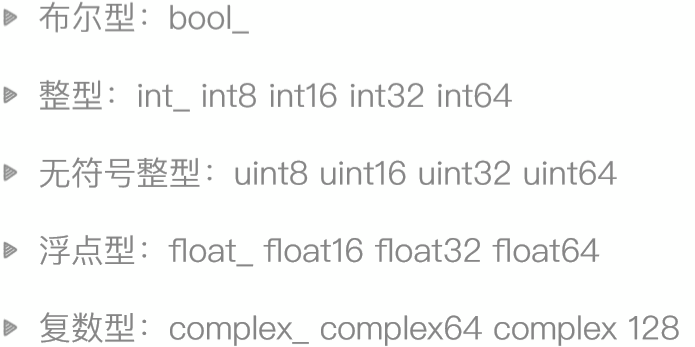
我们使用的巨大部分都是数字类型,它本身就是用来做计算的
64位数的长度是多少(2**63-1)
In \[25\]: 2\*\*64\-1
Out\[25\]: 18446744073709551615
- 1
- 2
numpy-array的创建
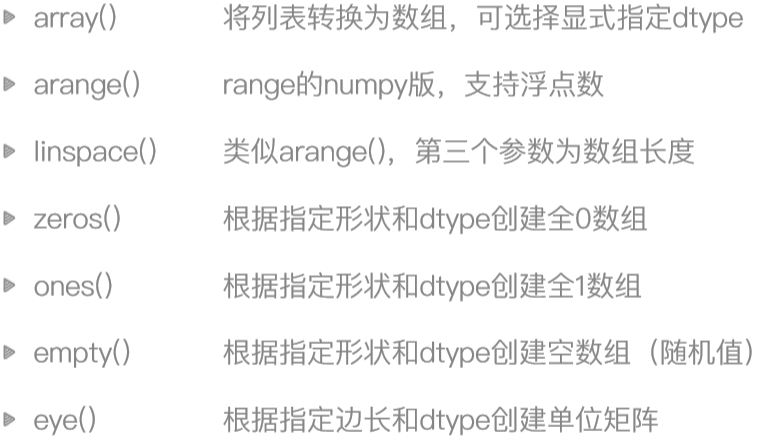
In \[1\]: # 可以这样创建一个10位全是0的数组 In \[2\]: import numpy as np In \[3\]: a = np.array(\[0\]\*10) In \[4\]: a Out\[4\]: array(\[0, 0, 0, 0, 0, 0, 0, 0, 0, 0\]) In \[5\]: # 也可以用zeros创建 In \[6\]: b = np.zeros(10) In \[7\]: b Out\[7\]: array(\[0., 0., 0., 0., 0., 0., 0., 0., 0., 0.\]) In \[8\]: # 可以看见都是0.,说明他是一个浮点数,来看一下类型 In \[9\]: b.dtype Out\[9\]: dtype('float64') In \[10\]: # 创建的时候指定类型,不使用默认的,直接用int In \[11\]: c = np.zeros(10,dtype='int') In \[12\]: c Out\[12\]: array(\[0, 0, 0, 0, 0, 0, 0, 0, 0, 0\]) In \[13\]: c.dtype Out\[13\]: dtype('int32') In \[14\]: # 创建全是1的数组 In \[15\]: d = np.ones(10) In \[16\]: d Out\[16\]: array(\[1., 1., 1., 1., 1., 1., 1., 1., 1., 1.\]) In \[17\]: # 看一下empty的用法,创建空数组,里面放的都是随机数 In \[18\]: e = np.empty(50) In \[19\]: e Out\[19\]: array(\[1.23004319e-311, 1.23004150e-311, 2.95806213e-311, 1.26927730e-277, 5.54041819e+228, 2.84855906e-311, 5.97288716e-299, 3.28487474e-311, 9.43293441e-314, 2.26784710e-308, 1.23004306e-311, 1.23002517e-311, 3.38460664e+125, 6.69053866e+151, 6.56693077e-085, 1.03564308e-308, 1.33360293e+241, 1.71632673e+243, 5.96115807e+228, 1.71011791e+214, 5.67517369e-311, 1.00562508e-248, 2.85308965e-313, 2.14793507e-308, 1.38760675e+219, 2.92135768e+209, 2.21211602e+214, 2.28723653e-308, 6.96983359e+228, 1.33360298e+241, 2.11280666e+161, 1.29883065e+219, 1.11074825e-310, 1.46972270e-200, 4.97508544e-313, 4.65203811e+151, 4.66820502e+180, 5.61168418e-313, 3.81674046e-308, 1.33360303e+241, 1.54523733e-310, 5.03961303e-266, 3.99046880e-008, 2.08868046e-310, 2.53185169e-212, 7.44726967e-251, 1.39069238e-309, 2.75926410e-306, 4.90398331e-307, 5.23951796e+202\]) In \[20\]: # 这些随机值是,之前内存的残存值。这个empty有什么用呢? In \[21\]: # 为了之后给里面赋值,因为它相对于zeros和ones创建的时候少了1个步骤,会更快一点 In \[22\]: # arange可以指定步长为小数,pyton中是不可以的 In \[24\]: f = np.arange(1,10,0.3) In \[25\]: f Out\[25\]: array(\[1\. , 1.3, 1.6, 1.9, 2.2, 2.5, 2.8, 3.1, 3.4, 3.7, 4. , 4.3, 4.6, 4.9, 5.2, 5.5, 5.8, 6.1, 6.4, 6.7, 7. , 7.3, 7.6, 7.9, 8.2, 8.5, 8.8, 9.1, 9.4, 9.7\]) In \[26\]: # linspace线性空间,和arange非常相,但是完全不一样,把指定的范围数字分成间隔相同的份数,最后一个参数是数组的长度,即份数 In \[31\]: k = np.linspace(0,5,10) 或者是 np.linespace(0,5,num=10) In \[32\]: k #并且linspace不像arange不包含最后一个数,它是包含最后一个数的,可以在最后看见5 Out\[32\]: array(\[0. , 0.55555556, 1.11111111, 1.66666667, 2.22222222, 2.77777778, 3.33333333, 3.88888889, 4.44444444, 5. \]) In \[27\]: g = np.linspace(1,100,100) In \[28\]: g Out\[28\]: array(\[ 1., 2., 3., 4., 5., 6., 7., 8., 9., 10., 11., 12., 13., 14., 15., 16., 17., 18., 19., 20., 21., 22., 23., 24., 25., 26., 27., 28., 29., 30., 31., 32., 33., 34., 35., 36., 37., 38., 39., 40., 41., 42., 43., 44., 45., 46., 47., 48., 49., 50., 51., 52., 53., 54., 55., 56., 57., 58., 59., 60., 61., 62., 63., 64., 65., 66., 67., 68., 69., 70., 71., 72., 73., 74., 75., 76., 77., 78., 79., 80., 81., 82., 83., 84., 85., 86., 87., 88., 89., 90., 91., 92., 93., 94., 95., 96., 97., 98., 99., 100.\]) In \[33\]: #eye 生成单位矩阵,对角线上都是1,不做线性代数,基本不会遇到 In \[37\]: w = np.eye(5) In \[38\]: w Out\[38\]: array(\[\[1., 0., 0., 0., 0.\], \[0., 1., 0., 0., 0.\], \[0., 0., 1., 0., 0.\], \[0., 0., 0., 1., 0.\], \[0., 0., 0., 0., 1.\]\])
- 1
- 2
- 3
- 4
- 5
- 6
- 7
- 8
- 9
- 10
- 11
- 12
- 13
- 14
- 15
- 16
- 17
- 18
- 19
- 20
- 21
- 22
- 23
- 24
- 25
- 26
- 27
- 28
- 29
- 30
- 31
- 32
- 33
- 34
- 35
- 36
- 37
- 38
- 39
- 40
- 41
- 42
- 43
- 44
- 45
- 46
- 47
- 48
- 49
- 50
- 51
- 52
- 53
- 54
- 55
- 56
- 57
- 58
- 59
- 60
- 61
- 62
- 63
- 64
- 65
- 66
- 67
- 68
- 69
- 70
- 71
- 72
- 73
- 74
- 75
- 76
- 77
- 78
- 79
- 80
- 81
- 82
- 83
ndarray-批量运算
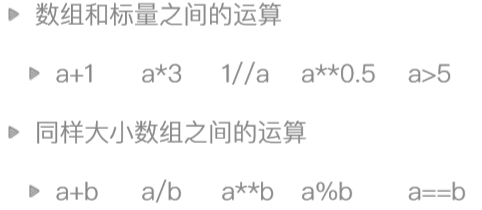
比较运算最后得到的是布尔值

如何快速生成一个二维数组
In \[39\]: np.arange(15).reshape((3,5))
Out\[39\]:
array(\[\[ 0, 1, 2, 3, 4\],
\[ 5, 6, 7, 8, 9\],
\[10, 11, 12, 13, 14\]\])
- 1
- 2
- 3
- 4
- 5
ndarray-索引
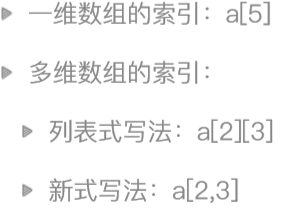
array(\[\[ 0, 1, 2, 3, 4\],
\[ 5, 6, 7, 8, 9\],
\[10, 11, 12, 13, 14\]\])
In \[40\]: a = np.arange(15).reshape((3,5))
In \[41\]: a\[2,2\]
Out\[41\]: 12
- 1
- 2
- 3
- 4
- 5
- 6
- 7
- 8
adarray-切片

也是前包后不包
In \[46\]: f
Out\[46\]:
array(\[1\. , 1.3, 1.6, 1.9, 2.2, 2.5, 2.8, 3.1, 3.4, 3.7, 4. , 4.3, 4.6,
4.9, 5.2, 5.5, 5.8, 6.1, 6.4, 6.7, 7. , 7.3, 7.6, 7.9, 8.2, 8.5,
8.8, 9.1, 9.4, 9.7\])
In \[48\]: f\[1:3\]
Out\[48\]: array(\[1.3, 1.6\])
- 1
- 2
- 3
- 4
- 5
- 6
- 7
- 8
但是数组切片,为了省空间,在切片的时候只是浅拷贝
如果要不影响原数组,切片的时候使用copy
In \[55\]: b = f\[0:5\] In \[56\]: b Out\[56\]: array(\[1. , 1.3, 1.6, 1.9, 2.2\]) In \[57\]: b\[0\] = 5 In \[58\]: b Out\[58\]: array(\[5. , 1.3, 1.6, 1.9, 2.2\]) In \[59\]: f Out\[59\]: array(\[5\. , 1.3, 1.6, 1.9, 2.2, 2.5, 2.8, 3.1, 3.4, 3.7, 4. , 4.3, 4.6, 4.9, 5.2, 5.5, 5.8, 6.1, 6.4, 6.7, 7. , 7.3, 7.6, 7.9, 8.2, 8.5, 8.8, 9.1, 9.4, 9.7\]) 使用copy b = f\[0:5\].copy()
- 1
- 2
- 3
- 4
- 5
- 6
- 7
- 8
- 9
- 10
- 11
- 12
- 13
- 14
- 15
- 16
- 17
多行切片
In \[49\]: a
Out\[49\]:
array(\[\[ 0, 1, 2, 3, 4\],
\[ 5, 6, 7, 8, 9\],
\[10, 11, 12, 13, 14\]\])
In \[50\]: # 多行切片,可以看做是\[切行,切列\]
In \[54\]: a\[0:2,0:2\]
Out\[54\]:
array(\[\[0, 1\],
\[5, 6\]\])
- 1
- 2
- 3
- 4
- 5
- 6
- 7
- 8
- 9
- 10
ndarray-布尔型索引
需求:选出列表中大于5的数

In \[60\]: import random # 用列表的filter方法 In \[61\]: a = \[random.randint(0,10) for i in range(20)\] In \[62\]: a Out\[62\]: \[1, 2, 1, 6, 1, 8, 6, 7, 3, 0, 6, 8, 2, 6, 0, 1, 4, 10, 0, 3\] In \[63\]: list(filter(lambda x:x>5, a)) Out\[63\]: \[6, 8, 6, 7, 6, 8, 6, 10\] # 用数组的布尔值索引 In \[64\]: a = np.array(a) In \[65\]: a\[a>5\] Out\[65\]: array(\[ 6, 8, 6, 7, 6, 8, 6, 10\]) In \[66\]: # 布尔型索引的原理 In \[67\]: # 第一步 a>5 In \[68\]: a>5 Out\[68\]: array(\[False, False, False, True, False, True, True, True, False, False, True, True, False, True, False, False, False, True, False, False\]) In \[69\]: # 第二步,返回每一位置为ture的位置的值 In \[70\]: b = np.array(\[1,2,3\]) In \[71\]: c = np.array(\[True,False,True\]) In \[72\]: b\[c\] Out\[72\]: array(\[1, 3\])
- 1
- 2
- 3
- 4
- 5
- 6
- 7
- 8
- 9
- 10
- 11
- 12
- 13
- 14
- 15
- 16
- 17
- 18
- 19
- 20
- 21
- 22
- 23
- 24
- 25
需求2:选出数组中大于5的偶数

题外:and 和 & 有什么区别?
ndarray-花式索引

注意:多维数组中,花式索引和花式索引不能出现在,逗号的两边
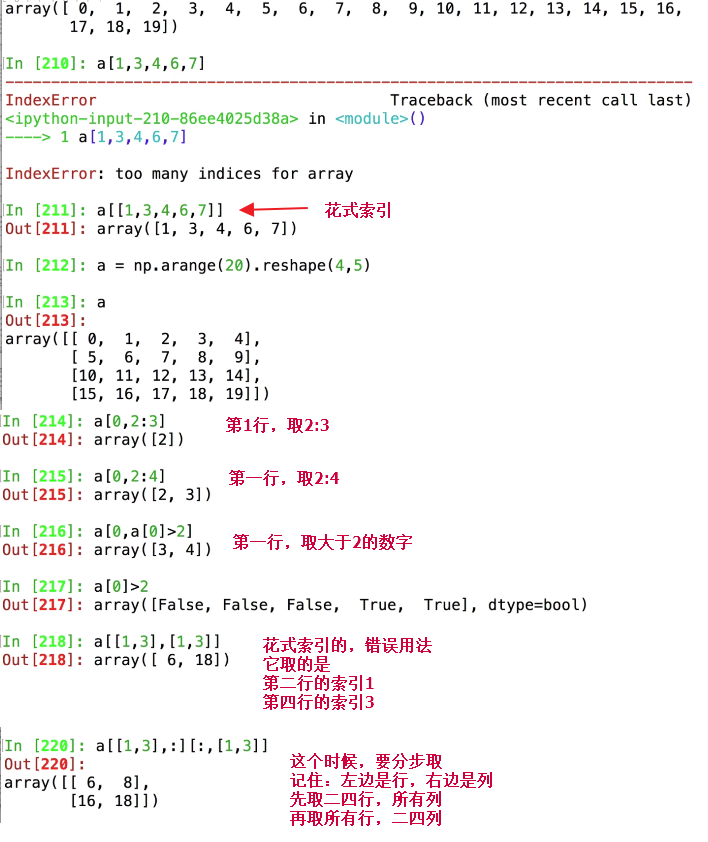
Numpy-通用函数
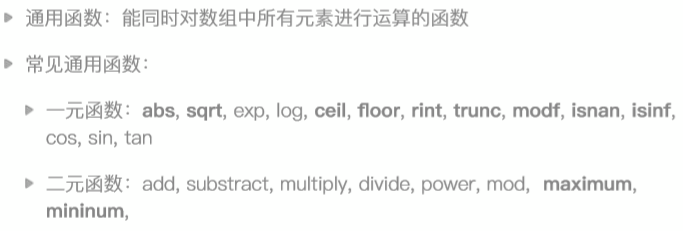
abs-批量求绝对值
In \[2\]: a = np.arange(-5,5)
In \[3\]: a
Out\[3\]: array(\[-5, -4, -3, -2, -1, 0, 1, 2, 3, 4\])
# 直接用abs也可以
In \[4\]: abs(a)
Out\[4\]: array(\[5, 4, 3, 2, 1, 0, 1, 2, 3, 4\])
# 严谨的用法是np.abs
In \[5\]: np.abs(a)
Out\[5\]: array(\[5, 4, 3, 2, 1, 0, 1, 2, 3, 4\])
- 1
- 2
- 3
- 4
- 5
- 6
- 7
- 8
- 9
aqrt-开方
# 直接使用会报错,没有这个sqrt,找不到 In \[7\]: sqrt(a) \--------------------------------------------------------------------------- NameError Traceback (most recent call last) <ipython-input-7-55c08d4e5fa4> in <module>() \----> 1 sqrt(a) NameError: name 'sqrt' is not defined # math模块下有sqrt In \[8\]: import math # 报错,sqrt一次只能处理一个值 In \[11\]: math.sqrt(a) \--------------------------------------------------------------------------- TypeError Traceback (most recent call last) <ipython-input-11-c85d302be686> in <module>() \----> 1 math.sqrt(a) TypeError: only size\-1 arrays can be converted to Python scalars # 使用np.sqrt ,因为负数不能求开方 In \[10\]: np.sqrt(a) F:\\Python36\\Scripts\\ipython3:1: RuntimeWarning: invalid value encountered in sqrt Out\[10\]: array(\[ nan, nan, nan, nan, nan, 0. , 1\. , 1.41421356, 1.73205081, 2. \])
- 1
- 2
- 3
- 4
- 5
- 6
- 7
- 8
- 9
- 10
- 11
- 12
- 13
- 14
- 15
- 16
- 17
- 18
- 19
- 20
- 21
- 22
- 23
- 24
把一个小数变成整数-取整和保留小数位
In \[12\]: a = 1.6 # 这种取整,叫做向0取整 In \[13\]: int(a) Out\[13\]: 1 # 这种叫做四舍五入 In \[14\]: round(a) Out\[14\]: 2 # 向上取整-ceil In \[15\]: math.ceil(a) Out\[15\]: 2 # 向下取整-floor In \[16\]: math.floor(a) Out\[16\]: 1 # 使用np In \[18\]: a Out\[18\]: array(\[-5.5, -4.5, -3.5, -2.5, -1.5, -0.5, 0.5, 1.5, 2.5, 3.5, 4.5\]) # 向下取整 In \[19\]: np.floor(a) Out\[19\]: array(\[-6., -5., -4., -3., -2., -1., 0., 1., 2., 3., 4.\]) # 向上取整 In \[22\]: np.ceil(a) Out\[22\]: array(\[-5., -4., -3., -2., -1., -0., 1., 2., 3., 4., 5.\]) # 四舍五入 In \[23\]: np.round(a) Out\[23\]: array(\[-6., -4., -4., -2., -2., -0., 0., 2., 2., 4., 4.\]) # rint和round是一样的 In \[20\]: np.rint(a) Out\[20\]: array(\[-6., -4., -4., -2., -2., -0., 0., 2., 2., 4., 4.\]) # 向0取整 In \[21\]: np.trunc(a) Out\[21\]: array(\[-5., -4., -3., -2., -1., -0., 0., 1., 2., 3., 4.\])
- 1
- 2
- 3
- 4
- 5
- 6
- 7
- 8
- 9
- 10
- 11
- 12
- 13
- 14
- 15
- 16
- 17
- 18
- 19
- 20
- 21
- 22
- 23
- 24
- 25
- 26
- 27
- 28
- 29
- 30
- 31
注:这里的round用的是"四舍六入五成双,奇进偶不进"的方法。对于大量的计算而言,比普通的四舍五入要更科学
modf-把小数和整数部分分开获取
In \[26\]: np.modf(a)
Out\[26\]:
(array(\[\-0.5, -0.5, -0.5, -0.5, -0.5, -0.5, 0.5, 0.5, 0.5, 0.5, 0.5\]),
array(\[\-5., -4., -3., -2., -1., -0., 0., 1., 2., 3., 4.\]))
In \[27\]: x,y = \_
In \[28\]: x
Out\[28\]: array(\[-0.5, -0.5, -0.5, -0.5, -0.5, -0.5, 0.5, 0.5, 0.5, 0.5, 0.5\])
In \[29\]: y
Out\[29\]: array(\[-5., -4., -3., -2., -1., -0., 0., 1., 2., 3., 4.\])
- 1
- 2
- 3
- 4
- 5
- 6
- 7
- 8
- 9
- 10
- 11
- 12
isnan和isinf-浮点数特殊值的判定

In \[31\]: a = np.ones(5) In \[32\]: a Out\[32\]: array(\[1., 1., 1., 1., 1.\]) In \[33\]: a\[1\] = 0 In \[34\]: a Out\[34\]: array(\[1., 0., 1., 1., 1.\]) In \[36\]: b = a/a F:\\Python36\\Scripts\\ipython3:1: RuntimeWarning: invalid value encountered in true\_divide In \[37\]: a Out\[37\]: array(\[1., 0., 1., 1., 1.\]) In \[38\]: b Out\[38\]: array(\[ 1., nan, 1., 1., 1.\]) In \[39\]: 1 in b Out\[39\]: True # 这样判断对nan是无用的 In \[40\]: np.nan in b Out\[40\]: False # isnan的作用 In \[41\]: np.isnan(b) Out\[41\]: array(\[False, True, False, False, False\])
- 1
- 2
- 3
- 4
- 5
- 6
- 7
- 8
- 9
- 10
- 11
- 12
- 13
- 14
- 15
- 16
- 17
- 18
- 19
- 20
- 21
- 22
- 23
- 24
- 25
- 26
- 27
isnan用来取值
In \[42\]: b\[np.isnan(b)\]
Out\[42\]: array(\[nan\])
In \[43\]: b\[~np.isnan(b)\]
Out\[43\]: array(\[1., 1., 1., 1.\])
- 1
- 2
- 3
- 4
- 5
inf-比任何数都大
In \[44\]: np.inf > 1000000000000000000000000000000
Out\[44\]: True
In \[45\]: float('inf') > 1000000000000000000000000000000000
Out\[45\]: True
- 1
- 2
- 3
- 4
- 5
inf和isinf的使用
In \[46\]: a = np.array(\[3,4,5,6,7\]) In \[47\]: b = np.array(\[3,0,5,0,7\]) In \[48\]: a/b F:\\Python36\\Scripts\\ipython3:1: RuntimeWarning: divide by zero encountered in true\_divide Out\[48\]: array(\[ 1., inf, 1., inf, 1.\]) # 和np.nan不一样,是相等的 In \[49\]: np.inf == np.inf Out\[49\]: True In \[50\]: c = a/b F:\\Python36\\Scripts\\ipython3:1: RuntimeWarning: divide by zero encountered in true\_divide In \[51\]: c Out\[51\]: array(\[ 1., inf, 1., inf, 1.\]) # 取出不是inf的值 In \[52\]: c\[c!=np.inf\] Out\[52\]: array(\[1., 1., 1.\]) # 取出不是inf的值,用~ In \[53\]: c\[~np.isinf(c)\] Out\[53\]: array(\[1., 1., 1.\])
- 1
- 2
- 3
- 4
- 5
- 6
- 7
- 8
- 9
- 10
- 11
- 12
- 13
- 14
- 15
- 16
- 17
- 18
- 19
二元函数
add 加
substract 减
multiply 乘
divide 除
power 乘方
mod 取模
- 1
- 2
- 3
- 4
- 5
- 6
maximum-对两个数组的每一个都取一个最大值
In \[58\]: a
Out\[58\]: array(\[3, 4, 5, 6, 7\])
In \[59\]: b
Out\[59\]: array(\[1, 6, 8, 9, 2\])
In \[60\]: np.maximum(a,b)
Out\[60\]: array(\[3, 6, 8, 9, 7\])
- 1
- 2
- 3
- 4
- 5
- 6
- 7
- 8
mininum-和maxinum一样的用法,只是对比取最小的值
更改数组形状-reshape和resize和ravel
a = np.random.random((3,2)) a # reshape 并不改变原始数组 a.reshape(2, 3) array(\[\[0.91122299, 0.93234796, 0.86025081\], \[0.33770259, 0.13627525, 0.78460434\]\]) # 查看 a array(\[\[0.91122299, 0.93234796\], \[0.86025081, 0.33770259\], \[0.13627525, 0.78460434\]\]) # resize 会改变原始数组 a.resize(2, 3) # 查看 a array(\[\[0.91122299, 0.93234796, 0.86025081\], \[0.33770259, 0.13627525, 0.78460434\]\]) \# 展平数组-数组变成一行 a.ravel()
- 1
- 2
- 3
- 4
- 5
- 6
- 7
- 8
- 9
- 10
- 11
- 12
- 13
- 14
- 15
- 16
- 17
- 18
- 19
- 20
- 21
array(\[0.91122299, 0.93234796, 0.86025081, 0.33770259, 0.13627525,
0.78460434\])
- 1
- 2
拼合数组-vstack和hstack
a = np.random.randint(10,size=(3,3)) b \= np.random.randint(10,size=(3,3)) a,b out: (array(\[\[1, 4, 7\], \[5, 6, 6\], \[6, 4, 5\]\]), array(\[\[8, 3, 1\], \[1, 5, 8\], \[5, 0, 6\]\])) # 垂直拼合 np.vstack((a,b)) out: array(\[\[1, 4, 7\], \[5, 6, 6\], \[6, 4, 5\], \[8, 3, 1\], \[1, 5, 8\], \[5, 0, 6\]\]) # 水平拼合 np.hstack((a,b)) array(\[\[1, 4, 7, 8, 3, 1\], \[5, 6, 6, 1, 5, 8\], \[6, 4, 5, 5, 0, 6\]\])
- 1
- 2
- 3
- 4
- 5
- 6
- 7
- 8
- 9
- 10
- 11
- 12
- 13
- 14
- 15
- 16
- 17
- 18
- 19
- 20
- 21
- 22
- 23
- 24
分割数组-vsplit和hsplit
# 沿横轴分割数组
np.hsplit(a,3)
\[array(\[\[1\],
\[5\],
\[6\]\]),
array(\[\[4\],
\[6\],
\[4\]\]),
array(\[\[7\],
\[6\],
\[5\]\])\]
# 沿纵轴分割数组
np.vsplit(a,3)
\[array(\[\[1, 4, 7\]\]), array(\[\[5, 6, 6\]\]), array(\[\[6, 4, 5\]\])\]
- 1
- 2
- 3
- 4
- 5
- 6
- 7
- 8
- 9
- 10
- 11
- 12
- 13
- 14
- 15
数组排序
# 生成示例数组 a = np.array((\[1, 4, 3\], \[6, 2, 9\], \[4, 7, 2\])) a array(\[\[1, 4, 3\], \[6, 2, 9\], \[4, 7, 2\]\]) # 返回每列最大值 np.max(a, axis=0) array(\[6, 7, 9\]) # 返回每行最小值 np.min(a,axis=1) array(\[1, 2, 2\]) # 返回每列最大值索引 np.argmax(a,axis=0) array(\[1, 2, 1\]) # 返回每行最小值索引 np.argmin(a,axis=1) array(\[0, 1, 2\])
- 1
- 2
- 3
- 4
- 5
- 6
- 7
- 8
- 9
- 10
- 11
- 12
- 13
- 14
- 15
- 16
- 17
- 18
- 19
- 20
- 21
- 22
numpy-统计方法和随机数生成

# 统计中位数
np.median(a, axis=0)
# 统计各行的算术平均值
np.mean(a, axis=1)
# 统计各列的加权平均值
np.average(a, axis=0)
# 统计各行的方差
np.var(a, axis=1)
# 统计数组各列的标准偏差
np.std(a, axis=0)
- 1
- 2
- 3
- 4
- 5
- 6
- 7
- 8
- 9
- 10
- 11
- 12
- 13
- 14
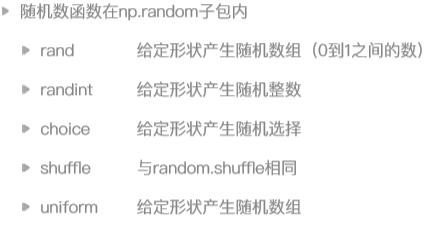
数学时间
1 2 3 4 5
平均数: 3
方差 :每个数\-3的值的平方,加在一起,再除以数字的个数
- 1
- 2
- 3

标准差:对方差开平方根
- 1

方差用来计算数组内数值的范围
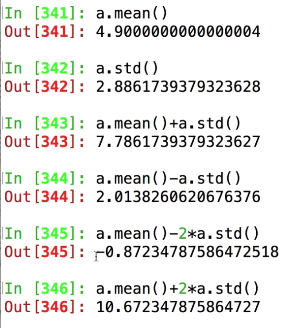
平均数加减两倍方差的结果活落在90%的范围上
矩阵乘法
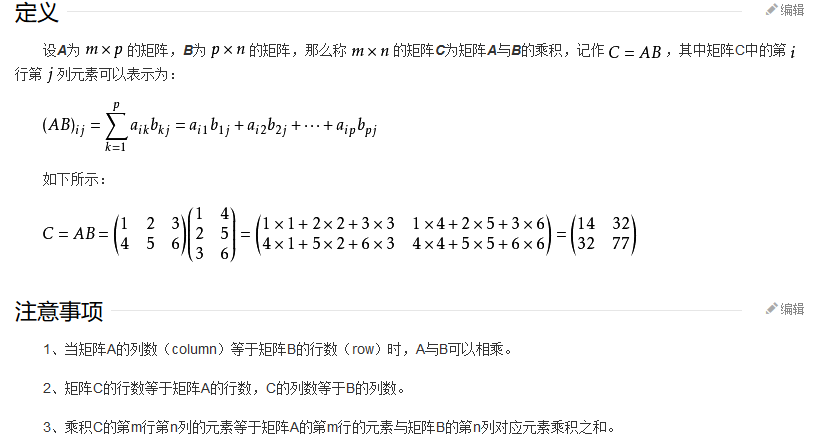
矩阵乘法运算(注意与a*b的区别)
A = np.array(\[\[1,2\],\[3,4\]\])
B = np.array(\[\[5,6\],\[7,8\]\])
np.dot(A,B)
array(\[\[19, 22\],
\[43, 50\]\])
- 1
- 2
- 3
- 4
- 5
- 6
数学函数
# 求三角函数 a = np.array(\[10,20,30,40,50\]) np.sin(a) array(\[\-0.54402111, 0.91294525, -0.98803162, 0.74511316, -0.26237485\]) # 以自然对数为底数的指数函数 np.exp(a) array(\[2.20264658e+04, 4.85165195e+08, 1.06864746e+13, 2.35385267e+17, 5.18470553e+21\]) # 方根的运算-开平方 np.sqrt(a) array(\[3.16227766, 4.47213595, 5.47722558, 6.32455532, 7.07106781\]) # 方根的运算-求立方 np.power(a,3) array(\[ 1000, 8000, 27000, 64000, 125000\])
- 1
- 2
- 3
- 4
- 5
- 6
- 7
- 8
- 9
- 10
- 11
- 12
- 13
- 14
- 15
- 16
- 17
- 18
随机数
# 创建二维随机数组
np.random.rand(2, 3)
array(\[\[0.46181641, 0.06400509, 0.93763711\],
\[0.67133387, 0.0801051 , 0.81633397\]\])
# 创建二维随机整数数组
np.random.randint(5, size=(2, 3))
array(\[\[4, 2, 2\],
\[4, 0, 0\]\])
- 1
- 2
- 3
- 4
- 5
- 6
- 7
- 8
- 9
In \[61\]: np.random.randint(0,10,10) Out\[61\]: array(\[6, 4, 8, 4, 0, 4, 9, 1, 5, 7\]) # 生成多维随机数组 In \[62\]: np.random.randint(0,10,(3,5)) 或者如上一个例子所示 使用size参数 Out\[62\]: array(\[\[4, 5, 7, 7, 8\], \[4, 1, 5, 1, 4\], \[2, 3, 9, 6, 8\]\]) # 0-1之间的随机数 In \[63\]: np.random.rand(10) Out\[63\]: array(\[0.97926997, 0.17454168, 0.52831388, 0.28070782, 0.2715298 , 0.2749287 , 0.44007621, 0.56472258, 0.53291951, 0.30727733\]) # 指定数组中的随机数 In \[64\]: np.random.choice(\[1,2,3,4,5,6\],10) Out\[64\]: array(\[1, 2, 5, 5, 2, 1, 5, 1, 3, 1\]) In \[65\]: np.random.choice(\[1,2,3,4,5,6\],(2,3)) Out\[65\]: array(\[\[5, 2, 3\], \[3, 4, 4\]\]) # uniform 平均分布,出现每一个小数的概率都一样 In \[67\]: np.random.uniform(2.0,4.0,10) Out\[67\]: array(\[3.30135597, 2.5034658 , 3.80415042, 3.58323964, 2.82819204, 3.45701693, 2.51628589, 3.94588971, 2.46530701, 3.269412 \]) In \[68\]: np.random.uniform(2,4,10) Out\[68\]: array(\[3.99532675, 2.27704994, 2.44378248, 2.33492658, 3.79537452, 2.6754694 , 3.04022564, 2.12863367, 3.27047096, 3.70261513\]) In \[69\]: # random中所有的方法都被numpy重写过
- 1
- 2
- 3
- 4
- 5
- 6
- 7
- 8
- 9
- 10
- 11
- 12
- 13
- 14
- 15
- 16
- 17
- 18
- 19
- 20
- 21
- 22
- 23
- 24
- 25
- 26
- 27
- 28
- 29
- 30
- 31
- 32
- 33
- 34
- 35
- 36
****fromfunction-依据自定义函数创建数组
\>>> def f(x,y): ... return 10\*x+y ... \>>> b = fromfunction(f,(5,4),dtype=int) \>>> b array(\[\[ 0, 1, 2, 3\], \[10, 11, 12, 13\], \[20, 21, 22, 23\], \[30, 31, 32, 33\], \[40, 41, 42, 43\]\]) # np.fromfunction(lambda i,j:i+j,(3,3)) array(\[\[0., 1., 2.\], \[1., 2., 3.\], \[2., 3., 4.\]\]) # 生成的规则就是数组中每一个元素所在位置的索引值作为x和y的值
- 1
- 2
- 3
- 4
- 5
- 6
- 7
- 8
- 9
- 10
- 11
- 12
- 13
- 14
- 15
- 16
- 17
还有很多高级功能没有说,numpy相对于pandas来说是比较基础的包
接下来请领教pandas
第三章-数据分析核心包—pandas
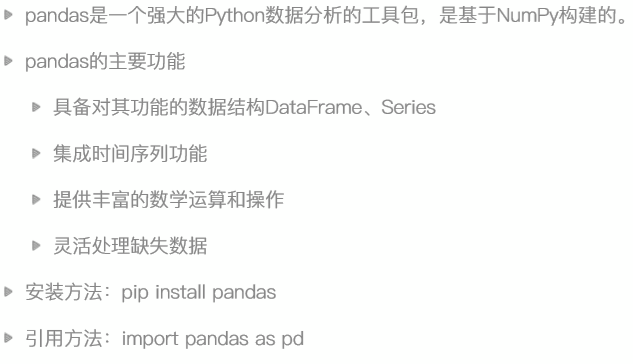
series-一维数据对象

In \[72\]: import pandas as pd In \[73\]: pd.Series(\[2,3,4,5\]) Out\[73\]: 0 2 1 3 2 4 3 5 dtype: int64 In \[74\]: pd.Series(\[2,3,4,5\],index=\['a','b','c','d'\]) Out\[74\]: a 2 b 3 c 4 d 5 dtype: int64 In \[75\]: # 所以说serries更像是列表和字典的结合体 In \[76\]: pd.Series(np.arange(5)) Out\[76\]: 0 0 1 1 2 2 3 3 4 4 dtype: int32 In \[77\]: # 在制定了索引之后,用原来的下标还是能访问 In \[82\]: sr = pd.Series(\[2,3,4,5\],index=\['a','b','c','d'\]) In \[83\]: sr Out\[83\]: a 2 b 3 c 4 d 5 dtype: int64 In \[84\]: sr\[2\] Out\[84\]: 4 # 所以他有两种索引方式,一种是下标,一种是标签,像字典的key
- 1
- 2
- 3
- 4
- 5
- 6
- 7
- 8
- 9
- 10
- 11
- 12
- 13
- 14
- 15
- 16
- 17
- 18
- 19
- 20
- 21
- 22
- 23
- 24
- 25
- 26
- 27
- 28
- 29
- 30
- 31
- 32
- 33
- 34
- 35
- 36
- 37
- 38
- 39
- 40
- 41
- 42
Series-使用特性
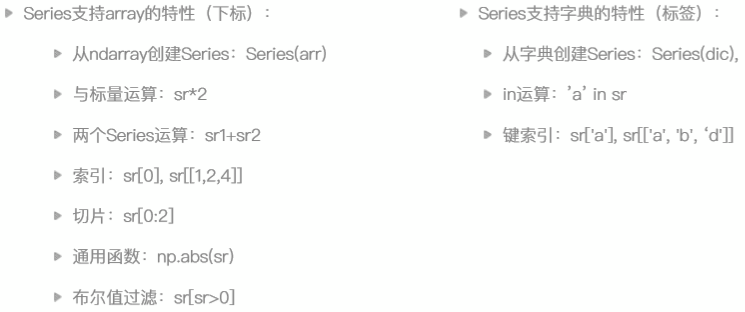
# 字典创建Series In \[85\]: sr = pd.Series({'a':1,'b':2}) In \[86\]: sr Out\[86\]: a 1 b 2 # 键索引 dtype: int64 In \[88\]: sr\['a'\] Out\[88\]: 1 # in的用法 In \[89\]: 'a' in sr Out\[89\]: True # 通过字典创建,也能使用下标索引 In \[87\]: sr\[1\] Out\[87\]: 2 # 和字典有一点不一样,写for循环的时候,for字典循环的是key,而Series遍历的是值 In \[90\]: for i in sr: ...: print(i) ...: 1 2 # 获取索引 In \[91\]: sr.index Out\[91\]: Index(\['a', 'b'\], dtype='object') In \[93\]: sr.index\[0\] Out\[93\]: 'a' # 获取值 In \[94\]: sr.values Out\[94\]: array(\[1, 2\], dtype=int64) In \[95\]: sr.values\[0\] Out\[95\]: 1 # 花式索引 In \[101\]: sr = pd.Series(a,index=\['a','b','c','d','e'\]) In \[102\]: sr Out\[102\]: a 3 b 4 c 5 d 6 e 7 dtype: int32 In \[103\]: sr\[\['a','e','c'\]\] Out\[103\]: a 3 e 7 c 5 dtype: int32 # 标签索引来切片,它是前包后也包的 In \[106\]: sr\['b':'d'\] Out\[106\]: b 4 c 5 d 6 dtype: int32
- 1
- 2
- 3
- 4
- 5
- 6
- 7
- 8
- 9
- 10
- 11
- 12
- 13
- 14
- 15
- 16
- 17
- 18
- 19
- 20
- 21
- 22
- 23
- 24
- 25
- 26
- 27
- 28
- 29
- 30
- 31
- 32
- 33
- 34
- 35
- 36
- 37
- 38
- 39
- 40
- 41
- 42
- 43
- 44
- 45
- 46
- 47
- 48
- 49
- 50
- 51
- 52
- 53
- 54
- 55
- 56
- 57
- 58
- 59
Series-整数索引问题

In \[107\]: sr = pd.Series(np.arange(10)) In \[108\]: sr Out\[108\]: 0 0 1 1 2 2 3 3 4 4 5 5 6 6 7 7 8 8 9 9 dtype: int32 In \[111\]: sr2 = sr\[5:\].copy() In \[112\]: sr2 Out\[112\]: 5 5 6 6 7 7 8 8 9 9 dtype: int32 # 问题开始了,sr2的下标索引并不是从0开始的 In \[113\]: sr2\[5\] Out\[113\]: 5 # 因为这个时候是有歧义的,所以,如果索引是整数类型,则根据整数进行下标取值的时候,总是面相标签的
- 1
- 2
- 3
- 4
- 5
- 6
- 7
- 8
- 9
- 10
- 11
- 12
- 13
- 14
- 15
- 16
- 17
- 18
- 19
- 20
- 21
- 22
- 23
- 24
- 25
- 26
- 27
- 28
- 29
解决办法:loc和iloc
In \[114\]: sr2.loc\[5\]
Out\[114\]: 5
In \[115\]: sr2.iloc\[-1\]
Out\[115\]: 9
# 因为长度只有5,所以使用sr.iloc\[5\]会报错
- 1
- 2
- 3
- 4
- 5
- 6
Series-数据对齐

按照标签索引进行计算
In \[117\]: sr1 = pd.Series(\[12,23,34\],index=\['c','a','d'\])
In \[118\]: sr2 = pd.Series(\[11,20,10\],index=\['d','c','a'\])
In \[119\]: sr1+sr2
Out\[119\]:
a 33
c 32
d 45
dtype: int64
- 1
- 2
- 3
- 4
- 5
- 6
- 7
- 8
- 9
pandas中长度不一样也可以计算,并引入NaN数据作为数据缺失值
In \[120\]: sr1 = pd.Series(\[12,23,34\],index=\['c','a','d'\])
In \[121\]: sr2 = pd.Series(\[11,20,10,16\],index=\['d','c','a','b'\])
In \[122\]: sr1+sr2
Out\[122\]:
a 33.0
**b NaN**
c 32.0
d 45.0
dtype: float64
- 1
- 2
- 3
- 4
- 5
- 6
- 7
- 8
- 9
- 10
- 11

In \[123\]: sr1 = pd.Series(\[12,23,34\],index=\['c','a','d'\])
In \[124\]: sr2 = pd.Series(\[11,20,10\],index=\['c','a','b'\])
In \[125\]: sr1+sr2
Out\[125\]:
a 43.0
b NaN
c 23.0
d NaN
dtype: float64
- 1
- 2
- 3
- 4
- 5
- 6
- 7
- 8
- 9
- 10
- 11
但是有的时候,我不需要他出现NaN
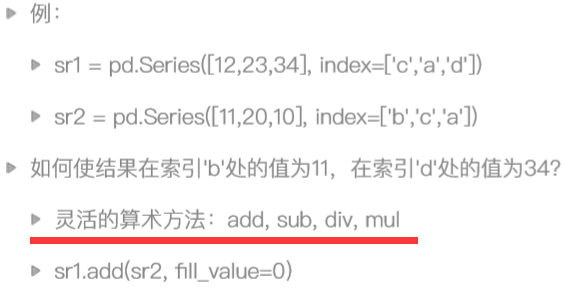
In \[126\]: sr1.add(sr2,fill\_value=0)
Out\[126\]:
a 43.0
b 10.0
c 23.0
d 34.0
dtype: float64
- 1
- 2
- 3
- 4
- 5
- 6
- 7
Series-缺失数据和处理确实数据
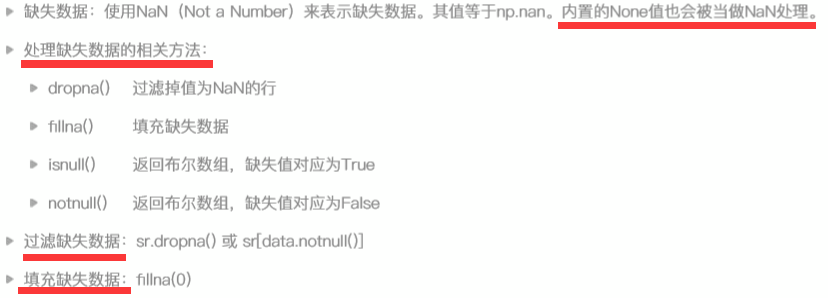
处理缺失数据有两种思路-删除和填充
判断有没有缺失数据-isnull和notnull
In \[127\]: sr.isnull()
Out\[127\]:
0 False
1 False
2 False
dtype: bool
- 1
- 2
- 3
- 4
- 5
- 6
删掉缺失数据的方法
# 恶意直接利用索引取值的方法
In \[132\]: sr\[sr.notnull()\]
Out\[132\]:
a 43.0
c 23.0
dtype: float64
# 使用dropna 删除
In \[134\]: sr.dropna()
Out\[134\]:
a 43.0
c 23.0
dtype: float64
- 1
- 2
- 3
- 4
- 5
- 6
- 7
- 8
- 9
- 10
- 11
- 12
填充的方法
# 使用fillna填充
In \[133\]: sr.fillna(0)
Out\[133\]:
a 43.0
b 0.0
c 23.0
d 0.0
dtype: float64
- 1
- 2
- 3
- 4
- 5
- 6
- 7
- 8
有的时候,不喜欢看见0 ,我们可以填充一个平均值
In \[135\]: sr.fillna(sr.mean())
Out\[135\]:
a 43.0
b 33.0
c 23.0
d 33.0
dtype: float64
- 1
- 2
- 3
- 4
- 5
- 6
- 7
pandas在计算平均值的时候,会跳过nan。如果不想跳过去,可以加一些参数
Series小结
Series的特性-数组+字典的结合体-
整数索引的问题\-loc和iloc
数据对齐\-面向标签和缺失值
缺失值的处理\-删除和填充
pandas的mean求平均值的特点的使用
- 1
- 2
- 3
- 4
- 5
DataFrame-二维数据对象

# 第一种创建范式 In \[137\]: df=pd.DataFrame({'one':\[1,2,3,\],'two':\[4,5,6\]}) In \[138\]: df Out\[138\]: one two 0 1 4 1 2 5 2 3 6 # 第二种创建方式 In \[140\]: pd.DataFrame({'one':pd.Series(\[1,2,3\],index=\['a','b','c'\]),'two':pd.Series(\[4,5,6,7\],index=\['a','b','c','d'\])}) Out\[140\]: one two a 1.0 4 b 2.0 5 c 3.0 6 d NaN 7 # 还有很多种创建的方式...
- 1
- 2
- 3
- 4
- 5
- 6
- 7
- 8
- 9
- 10
- 11
- 12
- 13
- 14
- 15
- 16
- 17
- 18
文件读写操作
vim test.csv
a,b,c
1,2,3
4,5,6
7,8,9
- 1
- 2
- 3
- 4
读取csv文件
In \[145\]: pd.read\_csv('test.csv')
Out\[145\]:
a b c
0 1 2 3
1 4 5 6
2 7 8 9
- 1
- 2
- 3
- 4
- 5
- 6
保存文件为csv
In \[147\]: df
Out\[147\]:
a b c
0 1 2 3
1 4 5 6
2 7 8 9
In \[148\]: df.to\_csv('test2.csv')
- 1
- 2
- 3
- 4
- 5
- 6
- 7
- 8
DataFrame-常用属性

index用来获取行索引,values获取的值是二维数组, 这是和Series一样的地方
In \[156\]: df = \_140 In \[157\]: df Out\[157\]: one two a 1.0 4 b 2.0 5 c 3.0 6 d NaN 7 In \[158\]: df.index Out\[158\]: Index(\['a', 'b', 'c', 'd'\], dtype='object') In \[159\]: df.values Out\[159\]: array(\[\[ 1., 4.\], \[ 2., 5.\], \[ 3., 6.\], \[nan, 7.\]\])
- 1
- 2
- 3
- 4
- 5
- 6
- 7
- 8
- 9
- 10
- 11
- 12
- 13
- 14
- 15
- 16
- 17
- 18
- 19
转置T-把行变成列,列变成行,且一列都成了一个属性(所有的转置默认都会)
可以指定属性dtype
In \[160\]: df.T
Out\[160\]:
a b c d
one 1.0 2.0 3.0 NaN
two 4.0 5.0 6.0 7.0
- 1
- 2
- 3
- 4
- 5
获取列索引columns
In \[163\]: df.columns
Out\[163\]: Index(\['one', 'two'\], dtype='object')
- 1
- 2
快速统计
In \[165\]: df.describe()
Out\[165\]:
one two
count 3.0 4.000000 个数
mean 2.0 5.500000 平均数 std 1.0 1.290994 标准差
min 1.0 4.000000 最小值
25% 1.5 4.750000 25%位置的数
50% 2.0 5.500000 中位数
75% 2.5 6.250000 75%位置的数
max 3.0 7.000000 最大数
- 1
- 2
- 3
- 4
- 5
- 6
- 7
- 8
- 9
- 10
DataFrame-索引和切片

# 先选列。再选行 In \[168\]: df Out\[168\]: one two a 1.0 4 b 2.0 5 c 3.0 6 d NaN 7 In \[169\]: df\['one'\]\['a'\] Out\[169\]: 1.0 In \[170\]: df\['one'\]\[1\] Out\[170\]: 2.0 In \[171\]: df\['one'\]\[0\] Out\[171\]: 1.0
- 1
- 2
- 3
- 4
- 5
- 6
- 7
- 8
- 9
- 10
- 11
- 12
- 13
- 14
- 15
- 16
- 17
建议使用loc或者iloc指定,并不建议使用双中括号
In \[172\]: df.loc\['a','one'\]
Out\[172\]: 1.0
In \[173\]: df.loc\['a',:\]
Out\[173\]:
one 1.0
two 4.0
Name: a, dtype: float64
- 1
- 2
- 3
- 4
- 5
- 6
- 7
- 8
灵活搭配使用
In \[174\]: df.loc\[\['a','c'\],:\]
Out\[174\]:
one two
a 1.0 4
c 3.0 6
- 1
- 2
- 3
- 4
- 5
DataFrame-数据对齐与缺失数据

DataFrame在使用dropna时,如果一行有一个缺失值,会将整行都删除
指定how=‘all’,删除全部是nan的行
In \[177\]: df.loc\[\['c','d'\],'two'\] = np.nan In \[178\]: df Out\[178\]: one two a 1.0 4.0 b 2.0 5.0 c 3.0 NaN d NaN NaN In \[179\]: df.dropna(how='all') Out\[179\]: one two a 1.0 4.0 b 2.0 5.0 c 3.0 NaN # how 默认的值是any,也就是只要有nan就都会删除
- 1
- 2
- 3
- 4
- 5
- 6
- 7
- 8
- 9
- 10
- 11
- 12
- 13
- 14
- 15
- 16
- 17
如何把有一列中有缺失值的那一列都删除?
axis参数意思是-轴,默认是0,是0的时候,指定的是行,1指定的是列
In \[184\]: df
Out\[184\]:
one two
a 1.0 4.0
b 2.0 5.0
c 3.0 NaN
d 5.0 NaN
In \[185\]: df.dropna(axis=1)
Out\[185\]:
one
a 1.0
b 2.0
c 3.0
d 5.0
- 1
- 2
- 3
- 4
- 5
- 6
- 7
- 8
- 9
- 10
- 11
- 12
- 13
- 14
- 15
pandas-其他常用方法
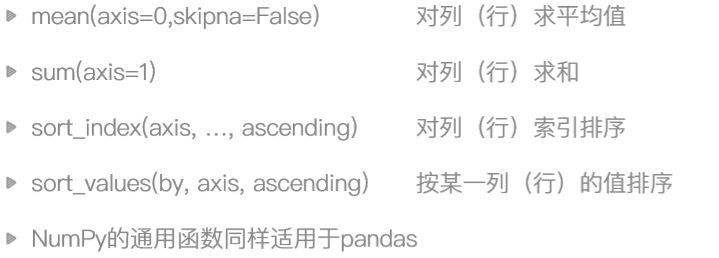

排序中的ascending=False是倒序,by是指定排序的行(列)
当排序的列(行)有nan的时候,都默认放在了最后,不参与排序
numpy的所有通用函数都适于用pandas
pandas-时间对象处理

datetime中将时间字符串转化成时间对象
In \[186\]: import datetime
In \[187\]: datetime.datetime.strptime('2010-01-01','%Y-%m-%d')
Out\[187\]: datetime.datetime(2010, 1, 1, 0, 0)
记忆strptime p--parse 解析
记忆strftime f--format 格式化
- 1
- 2
- 3
- 4
- 5
- 6
但是不是所有人写时间的格式都像这样的,有一个库可以帮我们做这件事
import dateutil
In \[191\]: dateutil.parser.parse('02/03/2010')
Out\[191\]: datetime.datetime(2010, 2, 3, 0, 0)
In \[192\]: dateutil.parser.parse('02-03-2010')
Out\[192\]: datetime.datetime(2010, 2, 3, 0, 0)
In \[193\]: dateutil.parser.parse('2010-JAN-10')
Out\[193\]: datetime.datetime(2010, 1, 10, 0, 0)
- 1
- 2
- 3
- 4
- 5
- 6
- 7
- 8
- 9
- 10
pandas中的to_datetime就是引用了这个模块,进行批量转换
In \[194\]: pd.to\_datetime(\['02-03-2010','2010-JAN-10'\])
Out\[194\]: DatetimeIndex(\['2010-02-03', '2010-01-10'\], dtype='datetime64\[ns\]', freq=None)
- 1
- 2
注意:得到对象第DatetimeIndex
时间对象生成-date_range

In \[195\]: pd.date\_range('2010-01-01','2010-05-01')
Out\[195\]:
DatetimeIndex(\['2010-01-01', '2010-01-02', '2010-01-03', '2010-01-04',
'2010-01-05', '2010-01-06', '2010-01-07', '2010-01-08',
'2010-01-09', '2010-01-10',
...
'2010-04-22', '2010-04-23', '2010-04-24', '2010-04-25',
'2010-04-26', '2010-04-27', '2010-04-28', '2010-04-29',
'2010-04-30', '2010-05-01'\],
dtype\='datetime64\[ns\]', length=121, freq='D')
- 1
- 2
- 3
- 4
- 5
- 6
- 7
- 8
- 9
- 10
使用periods指定长度
pd.date_range? 查看帮助中的参数帮助信息
start : str or datetime-like, optional Left bound for generating dates. end : str or datetime-like, optional Right bound for generating dates. periods : integer, optional **长度** Number of periods to generate. freq : str or DateOffset, default 'D' **频率 H-小时 W-周 W-MON W-WEN** Frequency strings can have multiples, e.g. **'**5H'. See //**B-工作日** :ref:\`here <timeseries.offset\_aliases>\` for a list of //**1H20min** frequency aliases. **date\_range的参数freq可以各种花式定义时间间隔** tz : str or tzinfo, optional Time zone name for returning localized DatetimeIndex, for example 'Asia/Hong\_Kong'. By default, the resulting DatetimeIndex is timezone\-naive. normalize : bool, default False Normalize start/end dates to midnight before generating date range. name : str, default None Name of the resulting DatetimeIndex. closed : {None, 'left', 'right'}, optional Make the interval closed with respect to the given frequency to the 'left', 'right', or both sides (None, the default).
- 1
- 2
- 3
- 4
- 5
- 6
- 7
- 8
- 9
- 10
- 11
- 12
- 13
- 14
- 15
- 16
- 17
- 18
- 19
- 20
- 21
- 22
得到的是Timestamp对象,可以将其用to_pydatetime转换成时间对象
还可以转成字符串
date_range的参数freq可以各种花式定义时间间隔
时间序列
生成的时间对象可以用来构建时间序列的
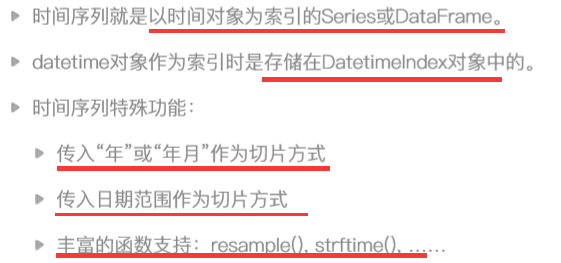
In \[198\]: sr = pd.Series(np.arange(5),index=pd.date\_range('2010-01-01',periods=5))
In \[199\]: sr
Out\[199\]:
2010-01-01 0
2010-01-02 1
2010-01-03 2
2010-01-04 3
2010-01-05 4
Freq: D, dtype: int32
- 1
- 2
- 3
- 4
- 5
- 6
- 7
- 8
- 9
- 10
那么有什么作用呢?直观的好处就是以时间为索引获取指定范围的数据
In \[200\]: sr = pd.Series(np.arange(100),index=pd.date\_range('2010-01-01',periods=100)) In \[201\]: sr\['2010-03'\] Out\[201\]: 2010-03-01 59 2010-03-02 60 2010-03-03 61 2010-03-04 62 2010-03-05 63 2010-03-06 64 2010-03-07 65 2010-03-08 66 2010-03-09 67 2010-03-10 68 2010-03-11 69 2010-03-12 70 2010-03-13 71 2010-03-14 72 2010-03-15 73 2010-03-16 74 2010-03-17 75 2010-03-18 76 2010-03-19 77 2010-03-20 78 2010-03-21 79 2010-03-22 80 2010-03-23 81 2010-03-24 82 2010-03-25 83 2010-03-26 84 2010-03-27 85 2010-03-28 86 2010-03-29 87 2010-03-30 88 2010-03-31 89 Freq: D, dtype: int32
- 1
- 2
- 3
- 4
- 5
- 6
- 7
- 8
- 9
- 10
- 11
- 12
- 13
- 14
- 15
- 16
- 17
- 18
- 19
- 20
- 21
- 22
- 23
- 24
- 25
- 26
- 27
- 28
- 29
- 30
- 31
- 32
- 33
- 34
- 35
- 36
还比如 sr[‘2017’:‘2018’]
特别方便
resample函数–重新取样
# 以周为单位取和 In \[203\]: sr.resample('W').sum() Out\[203\]: 2010-01-03 3 2010-01-10 42 2010-01-17 91 2010-01-24 140 2010-01-31 189 2010-02-07 238 2010-02-14 287 2010-02-21 336 2010-02-28 385 2010-03-07 434 2010-03-14 483 2010-03-21 532 2010-03-28 581 2010-04-04 630 2010-04-11 579 Freq: W\-SUN, dtype: int32
- 1
- 2
- 3
- 4
- 5
- 6
- 7
- 8
- 9
- 10
- 11
- 12
- 13
- 14
- 15
- 16
- 17
- 18
- 19
truncate是类似切片的函数,意义不大,因为都可以通过切片操作来取值
pandas-文件处理
读取文件

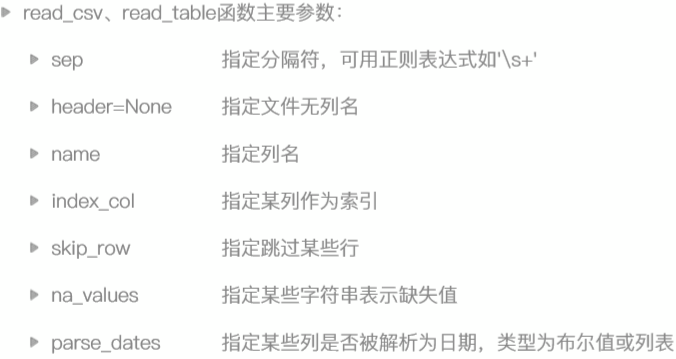
例子:

header= none

names的使用

在一个数据表中,如果某一列中有None,这整个列的类型都会变成object,变成了字符串

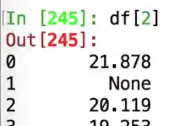
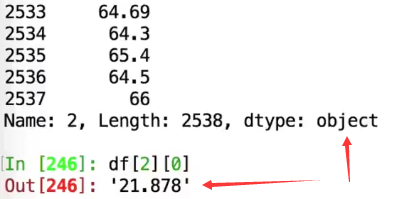 本来应该是float的
本来应该是float的
但是因为有none,变成了字符串
nan可以解释成浮点数,但是none无法解释,
解决:用na_values

写入文件
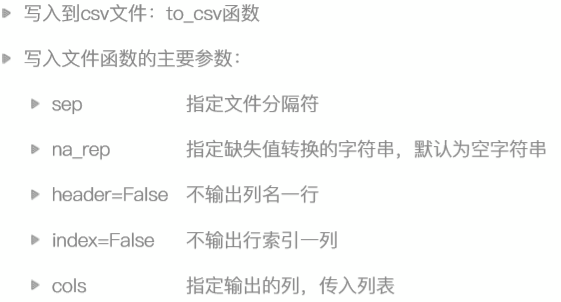
写入文件示例:




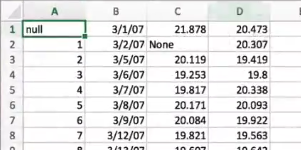



Python中读取excel的时候需要安装模块xlrd
…还有很多内容
要多多练习,才能掌握,变成自己的
第四章-数据可视化工具包—matplotlib
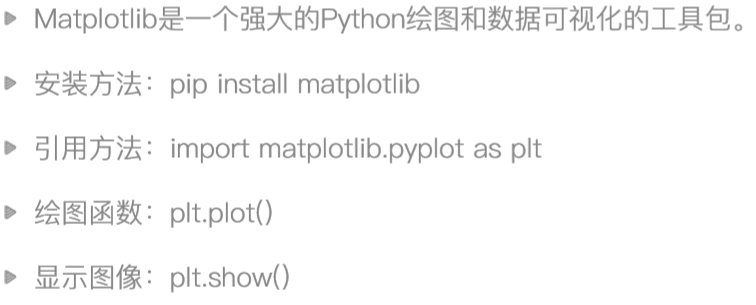

如果在命令行或者pycharm中运行,会弹出对话框,可以进行拖动、放大等操作…
plot函数

plot用来绘制点图或者线图,两个参数(即x和y)
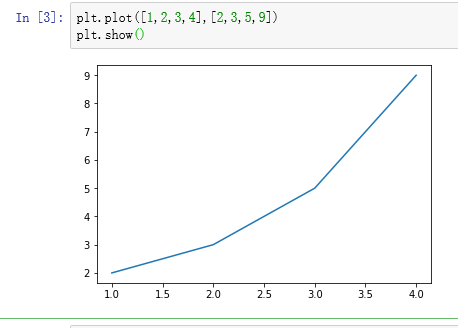
还有第三个参数,一个字符串,来决定线的样式(示例:v是小三角,用短线和点连接,显示红色)
也可以使用参数传递(color=‘red’,marker=‘^’,linestyle=‘-.’)
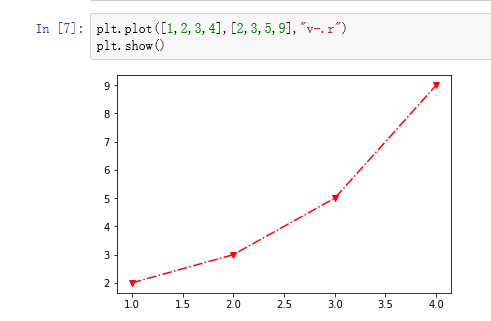
我想画多条线?该如何操作
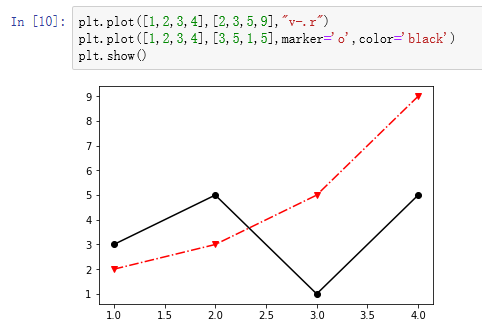
show函数,调用之后,之前的plot都出现在一张图上了
Matplotlib-图像标注


plt.legend的用法之一

pandas和Matplotlib

直接使用
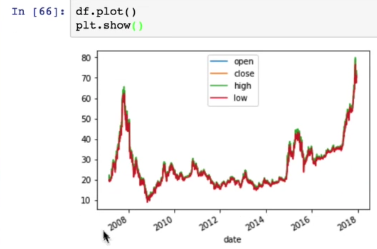
作业:绘制数学函数图像


画布与子图
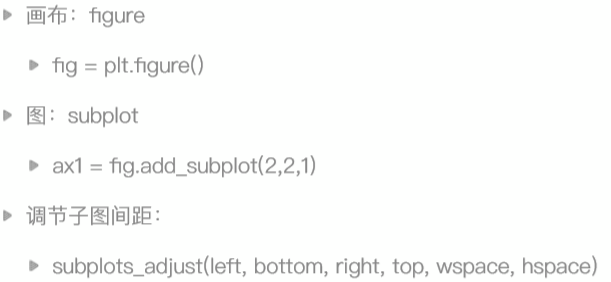
fig.add_subplot(2,2,1) 其中 2,2的意思就是把画布分成2x24份,最后的1是第一个位置
Matplotlib支持的图类型



条形图

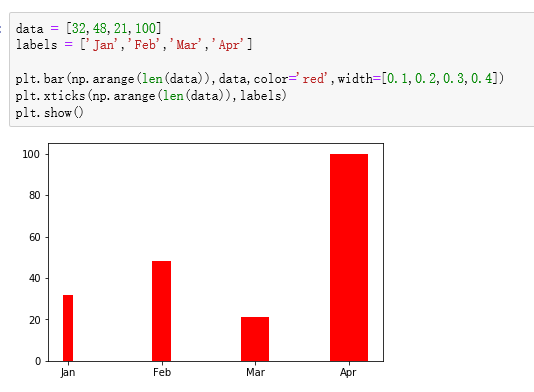
饼图

折线图-matplot.finance
matplotlib.finance.子包中有许多绘制金融相关图的函数接口
绘制K线图:matplotlib.finance.candlestick_ochl函数
参数的帮助信息

导入模块并给数据添加了一个time字段
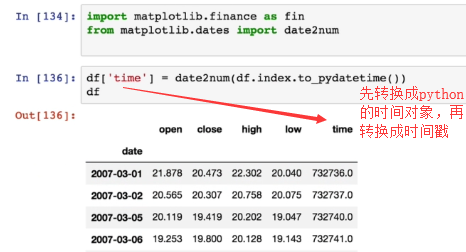


第五章-金融数据分析基础实战
tushare包介绍
Tushare是一个免费、开源的财经数据接口包。
练习1-股票数据分析
1、使用tushare包获取某股票的历史行情数据
2、输出该股票所有收盘比开盘上涨3%以上的日期
3、输出该股票所有开盘比前日收盘跌幅超过2%的日期(用shift错位)
4、加入我从2010年1月1日开始,每月第一个交易日买入一手股票,每年最后一个交易日卖出所有股票,
到今天为止,我的收益如何?
- 1
- 2
- 3
- 4
- 5
tushare接口的使用和shift函数,resample的使用
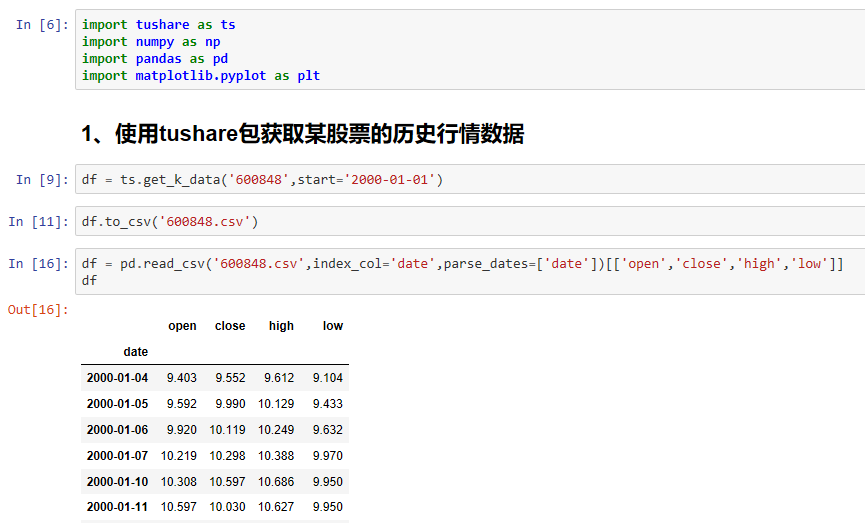
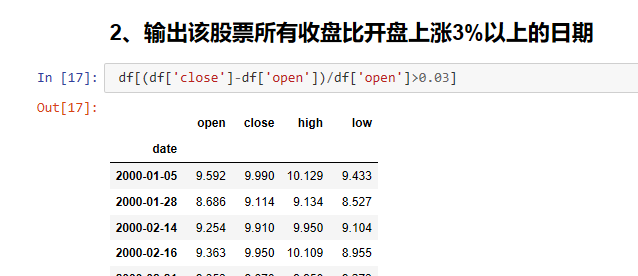
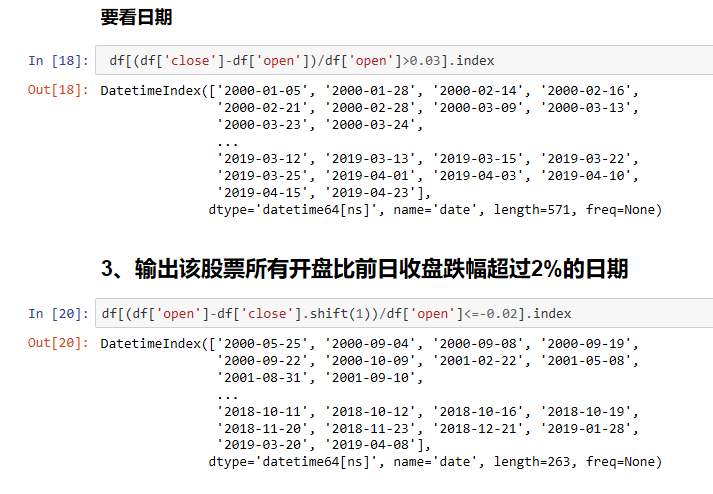

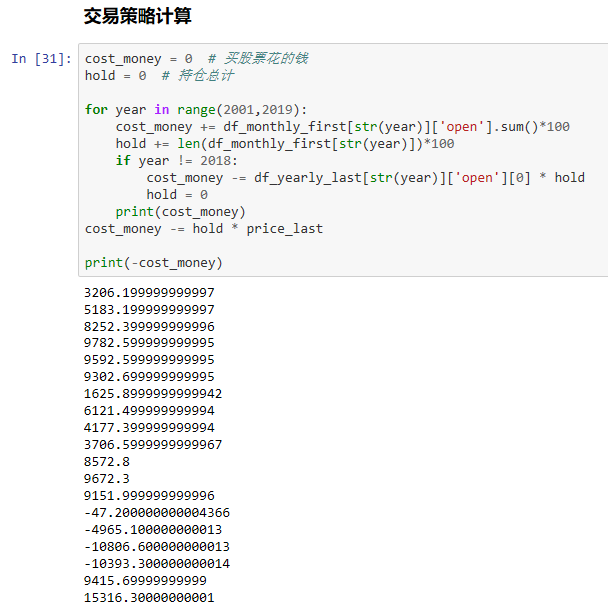
练习2-查找历史金叉死叉的日期
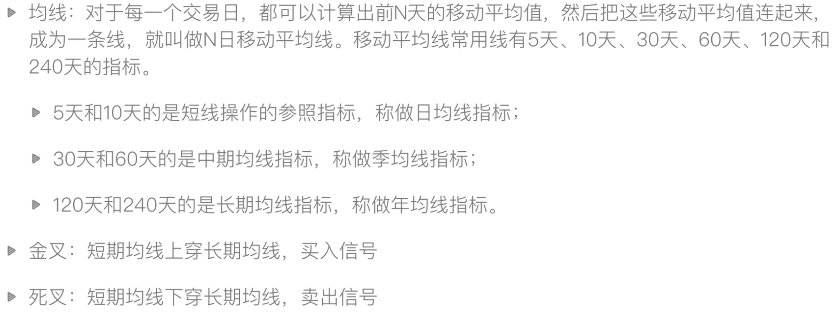

编写代码
第一个量化策略
基于聚宽编码和回测

initialize函数
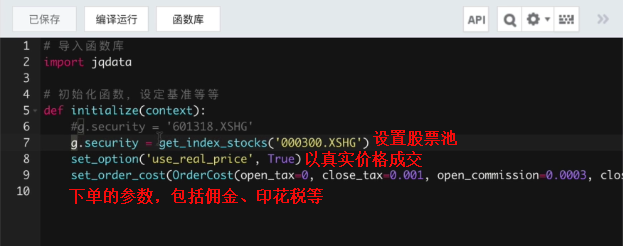
handle_data函数,每个单位时间执行一次回测

策略实现
# 导入函数库 from jqdata import \* # 初始化函数,设定基准等等 def initialize(context): # 1、设置股票池为沪深300的所有成分股 g.security = get\_index\_stocks('000300.XSHG') # 基准收益 set\_benchmark('000300.XSHG') # 持有后不动 set\_option('use\_real\_price',True) set\_order\_cost(OrderCost(open\_tax\=0, close\_tax=0.001, open\_commission=0.0003, close\_commission=0.0003, close\_today\_commission=0, min\_commission=5), type='stock') #\# 回测函数 def handle\_data(context, data): # 每只股票买多少的问题,账户金额/股票个数的长度=每个股票分多少钱 # 一般情况下先卖后买 tobuy = \[\] for stock in g.security: # 获取股票当前的开盘价 p = get\_current\_data()\[stock\].day\_open # 查看是否持有这只股票 amount = context.portfolio.positions\[stock\].total\_amount # 股票的持仓成本 cost = context.portfolio.positions\[stock\].avg\_cost # 3、如果当前股价比买入时上涨了25%,则清仓止盈 if amount > 0 and p >= cost \* 1.25: order\_target(stock,0) # 止盈 # 4、如果当前股价比买入时下跌了10%,则卖出止损 if amount > 0 and p <= cost \*0.9: order\_target(stock,0) # 止损 # 2、如果当前股价小于10元且当前不持仓,则买入 if p <= 10.0 and amount == 0: tobuy.append(stock) order(stock,1000) if tobuy: cost\_per\_stock \= context.portfolio.available\_cash / len(tobuy) for per in tobuy: order\_value(per,cost\_per\_stock)
- 1
- 2
- 3
- 4
- 5
- 6
- 7
- 8
- 9
- 10
- 11
- 12
- 13
- 14
- 15
- 16
- 17
- 18
- 19
- 20
- 21
- 22
- 23
- 24
- 25
- 26
- 27
- 28
- 29
- 30
- 31
- 32
- 33
- 34
- 35
- 36
- 37
- 38
双均线策略-最简单只股票
# 导入函数库 from jqdata import \* # 初始化函数,设定基准等等 def initialize(context): set\_benchmark('000300.XSHG') # 持有后不动 set\_option('use\_real\_price',True) set\_order\_cost(OrderCost(open\_tax\=0, close\_tax=0.001, open\_commission=0.0003, close\_commission=0.0003, close\_today\_commission=0, min\_commission=5), type='stock') # 选股 g.security = \['601318.XSHG'\] g.p1 \= 5 g.p2 \= 10 def handle\_data(context, data): for stock in g.security: # 金叉:如果5日均线大于10日均线,且没有持仓 # 死叉:如果5日均线小于10日均线,并且持仓 # 获取历史数据 df = attribute\_history(stock,g.p2) m10 \= df\['close'\].mean() m5 \= df\['close'\]\[-5:\].mean() if m10 > m5 and stock in context.portfolio.positions: # 死叉卖出 order\_target(stock, 0) if m10 < m5 and stock not in context.portfolio.positions: order(stock,context.portfolio.available\_cash \* 0.8)
- 1
- 2
- 3
- 4
- 5
- 6
- 7
- 8
- 9
- 10
- 11
- 12
- 13
- 14
- 15
- 16
- 17
- 18
- 19
- 20
- 21
- 22
- 23
- 24
- 25
- 26
- 27
- 28
- 29
- 30
在回测图上添加其他的图

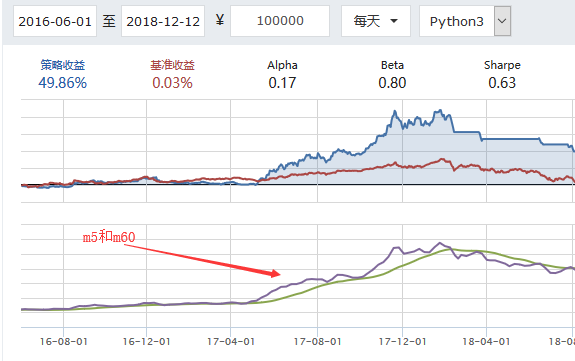
因子选股策略

查询财务数据
get_fundanmentals

策略编写
# 导入函数库 from jqdata import \* # 初始化函数,设定基准等等 def initialize(context): set\_benchmark('000300.XSHG') # 持有后不动 set\_option('use\_real\_price',True) set\_order\_cost(OrderCost(open\_tax\=0, close\_tax=0.001, open\_commission=0.0003, close\_commission\=0.0003, close\_today\_commission=0, min\_commission=5), type='stock') # 选股范围 g.security = get\_index\_stocks('000300.XSHG') # 获取数据,在官网数据选项卡中找到valuation表 g.q = query(valuation).filter(valuation.code.in\_(g.security)) # 要定期跟新调仓 # 1、定义天数变量,在handle\_data中计数,每天+1,当days%30==0的时候,执行调仓 # 这是没30个交易日调一次 # 2、使用run\_monthly(handle,1),定义handle用来跟新的函数,1表示第一个交易日 # 这是每月调一次 run\_monthly(handle,1) # 定义自己的仓位最多有20只股票 g.N = 20 def handle(context): # 注意,有的函数方法会报错,因为平台支持的第三方平台的版本所导致 df = get\_fundamentals(g.q)\[\['code','market\_cap'\]\] df \= df.sort\_values('market\_cap').iloc\[:g.N,:\] # 新选出的股票池 to\_hold = df\['code'\].values # 手上可能有一些股票,有的留着,没有的卖掉,添加新的 for stock in context.portfolio.positions: # 手上的股票没在to\_hold中,买掉 if stock not in to\_hold: order\_target(stock,0) to\_buy \= \[stock for stock in to\_hold if stock not in context.portfolio.positions\] if to\_buy: cash\_per\_stock \= context.portfolio.available\_cash / len(to\_buy) for per in to\_buy: order\_value(per,cash\_per\_stock)
- 1
- 2
- 3
- 4
- 5
- 6
- 7
- 8
- 9
- 10
- 11
- 12
- 13
- 14
- 15
- 16
- 17
- 18
- 19
- 20
- 21
- 22
- 23
- 24
- 25
- 26
- 27
- 28
- 29
- 30
- 31
- 32
- 33
- 34
- 35
- 36
- 37
- 38
- 39
- 40
- 41
- 42
- 43
- 44
注意停牌的股票的过滤
取前30个,把停牌的(paused)过滤掉,在取前20个

多因子选股策略
市值小
净资产收益率要高
如何同时综合多个因子
…

补充知识-标准化
标准化,归一化,数据预处理的方法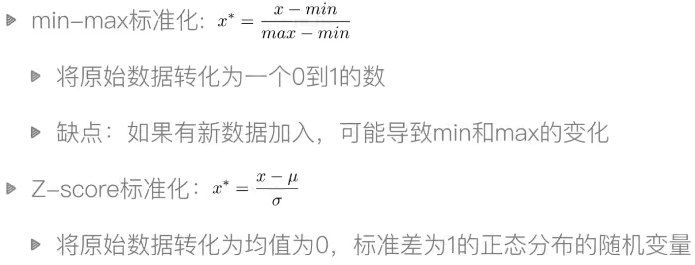
编码实现
# 导入函数库 from jqdata import \* # 初始化函数,设定基准等等 def initialize(context): set\_benchmark('000300.XSHG') # 持有后不动 set\_option('use\_real\_price',True) set\_order\_cost(OrderCost(open\_tax\=0, close\_tax=0.001, open\_commission=0.0003, close\_commission\=0.0003, close\_today\_commission=0, min\_commission=5), type='stock') # 选股范围 g.security = get\_index\_stocks('000002.XSHG') # 获取数据,在官网数据选项卡中找到valuation表,市值数据在这个表中 # 找到roe在,indicator表中 g.q = query(valuation,indicator).filter(valuation.code.in\_(g.security)) # 要定期跟新调仓 # 1、定义天数变量,在handle\_data中计数,每天+1,当days%30==0的时候,执行调仓 # 这是没30个交易日调一次 # 2、使用run\_monthly(handle,1),定义handle用来跟新的函数,1表示第一个交易日 # 这是每月调一次 # 定义自己的仓位最多有20只股票 g.N = 20 run\_monthly(handle,1) def handle(context): # 注意,有的函数方法会报错,因为平台支持的第三方平台的版本所导致 df = get\_fundamentals(g.q)\[\['code','market\_cap','roe'\]\] # 进行归一化 df\['market\_cap'\] = (df\['market\_cap'\]) - df\['market\_cap'\].min()) / (df\['market\_cap'\].max() - df\['market\_cap'\].min()) df\['roe'\] = (df\['roe'\]) - df\['roe'\].min()) / (df\['roe'\].max() - df\['roe'\].min()) # 增加一列作为评分,收益率越大越好,市值越小越好。最后的结果越大越好 df\['score'\] = df\['roe'\] - df\['market\_cap'\] # 选最后20只 df = df.sort\_values('score').iloc\[-g.N:,:\] # 新选出的股票池 to\_hold = df\['code'\].values # 手上可能有一些股票,有的留着,没有的卖掉,添加新的 for stock in context.portfolio.positions: # 手上的股票没在to\_hold中,买掉 if stock not in to\_hold: order\_target(stock,0) to\_buy \= \[stock for stock in to\_hold if stock not in context.portfolio.positions\] if to\_buy: cash\_per\_stock \= context.portfolio.available\_cash / len(to\_buy) for per in to\_buy: order\_value(per,cash\_per\_stock)
- 1
- 2
- 3
- 4
- 5
- 6
- 7
- 8
- 9
- 10
- 11
- 12
- 13
- 14
- 15
- 16
- 17
- 18
- 19
- 20
- 21
- 22
- 23
- 24
- 25
- 26
- 27
- 28
- 29
- 30
- 31
- 32
- 33
- 34
- 35
- 36
- 37
- 38
- 39
- 40
- 41
- 42
- 43
- 44
- 45
- 46
- 47
- 48
- 49
- 50
- 51
- 52
- 53
- 54
- 55
- 56
- 57
还可以增加权重、增加更多的因子
均值回归理论

均值回归策略是一个选股策略

编码实现
# 导入函数库 from jqdata import \* # 初始化函数,设定基准等等 def initialize(context): set\_benchmark('000300.XSHG') # 持有后不动 set\_option('use\_real\_price',True) set\_order\_cost(OrderCost(open\_tax\=0, close\_tax=0.001, open\_commission=0.0003, close\_commission\=0.0003, close\_today\_commission=0, min\_commission=5), type='stock') # 选股范围 g.security = get\_index\_stocks('000002.XSHG') # 均线 g.ma\_days = 30 # 股票数量 g.stock\_num = 10 run\_monthly(handle,1) def handle(context): sr \= pandas.Series(index=g.security) for stock in sr.index: ma \= attribute\_history(stock, g.ma\_days)\['close'\].mean() p \= get\_current\_data()\[stock\].day\_open # 计算偏离程度 ratio = (ma-p) / ma sr\[stock\] \= ratio # 不用sort,有一个更快的函数nlargest # 新选出的股票池 to\_hold = sr.nlargest(g.stock\_num).index.values # 手上可能有一些股票,有的留着,没有的卖掉,添加新的 for stock in context.portfolio.positions: # 手上的股票没在to\_hold中,买掉 if stock not in to\_hold: order\_target(stock,0) to\_buy \= \[stock for stock in to\_hold if stock not in context.portfolio.positions\] if to\_buy: cash\_per\_stock \= context.portfolio.available\_cash / len(to\_buy) for per in to\_buy: order\_value(per,cash\_per\_stock)
- 1
- 2
- 3
- 4
- 5
- 6
- 7
- 8
- 9
- 10
- 11
- 12
- 13
- 14
- 15
- 16
- 17
- 18
- 19
- 20
- 21
- 22
- 23
- 24
- 25
- 26
- 27
- 28
- 29
- 30
- 31
- 32
- 33
- 34
- 35
- 36
- 37
- 38
- 39
- 40
- 41
- 42
- 43
- 44
- 45
- 46
布林带策略

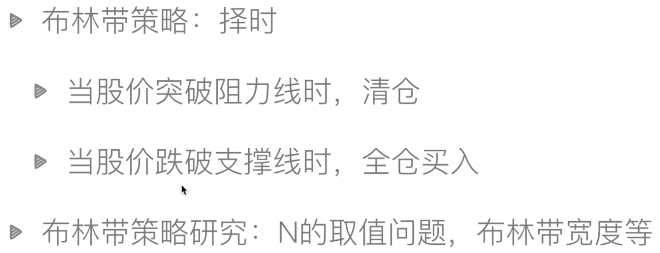
上下N取小了不好,去大了等于没取,因为很难触碰,上下可以取不同的N
编码实现
# 导入函数库 from jqdata import \* # 初始化函数,设定基准等等 def initialize(context): set\_benchmark('000300.XSHG') # 持有后不动 set\_option('use\_real\_price',True) set\_order\_cost(OrderCost(open\_tax\=0, close\_tax=0.001, open\_commission=0.0003, close\_commission\=0.0003, close\_today\_commission=0, min\_commission=5), type='stock') # 选股范围 g.security = ('600036.XSHG') g.M \= 20 # 试验过20比较好 g.k = 2 # 听说1.7比较好 # 初始化策略 def handle\_data(context, data): sr \= attribute\_history(g.security,g.M)\['close'\] ma \= sr.mean() up \= ma + g.k \* sr.std() down \= ma - g.k \* sr.std() p \= get\_current\_data()\[g.security\].day\_open cash \= context.portfolio.available\_cash if p < down and g.security not in context.portfolio.positions: order\_value(g.security, cash) elif p >up and g.security in context.portfolio.positions: order\_target(g.security, 0)
- 1
- 2
- 3
- 4
- 5
- 6
- 7
- 8
- 9
- 10
- 11
- 12
- 13
- 14
- 15
- 16
- 17
- 18
- 19
- 20
- 21
- 22
- 23
- 24
- 25
- 26
- 27
可以继续尝试其他股票或者多只股票
多只股票牵涉资金分配的问题
多尝试几个参数,看效果如何
布林带比较窄的时候,说明波动小,将不适合短线交易,也可将其作为一个因子
加入止损操作
PEG策略

市盈率是什么

PEG策略说明
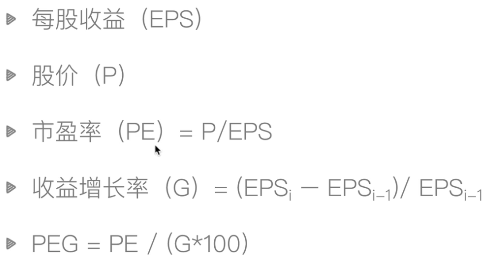

PEG选股

编码实现
市盈率有静态的和动态的两种,我们使用静态的pe_ratio,在valuation表中
收益增长率inc_net_profit_year_on_year,在indicator里面
# 导入函数库 from jqdata import \* # 初始化函数,设定基准等等 def initialize(context): set\_benchmark('000300.XSHG') # 持有后不动 set\_option('use\_real\_price',True) set\_order\_cost(OrderCost(open\_tax\=0, close\_tax=0.001, open\_commission=0.0003, close\_commission\=0.0003, close\_today\_commission=0, min\_commission=5), type='stock') # 选股范围 g.security = get\_index\_stocks('000300.XSHG') g.q \= query(valuation.code,valuation.pe\_ratio,indicator.inc\_net\_profit\_year\_on\_year).filter(valuation.code.in\_(g.security)) g.N \= 20 run\_monthly(handle,1) def handle(context): df \= get\_fundamentals(g.q) # 过滤负值的PEG df = df\[(df\['pe\_ratio'\] > 0) & (df\['inc\_net\_profit\_year\_on\_year'\] > 0) \] # 计算peg df\['peg'\] = df\['pe\_ratio'\] /df\['inc\_net\_profit\_year\_on\_year'\]/100 df \= df.sort\_values('peg') to\_hold \= df\['code'\]\[:g.N\].values print(to\_hold) # 手上可能有一些股票,有的留着,没有的卖掉,添加新的 for stock in context.portfolio.positions: # 手上的股票没在to\_hold中,买掉 if stock not in to\_hold: order\_target(stock,0) to\_buy \= \[stock for stock in to\_hold if stock not in context.portfolio.positions\] if to\_buy: cash\_per\_stock \= context.portfolio.available\_cash / len(to\_buy) for per in to\_buy: order\_value(per,cash\_per\_stock)
- 1
- 2
- 3
- 4
- 5
- 6
- 7
- 8
- 9
- 10
- 11
- 12
- 13
- 14
- 15
- 16
- 17
- 18
- 19
- 20
- 21
- 22
- 23
- 24
- 25
- 26
- 27
- 28
- 29
- 30
- 31
- 32
- 33
- 34
- 35
- 36
- 37
动量策略和反转策略


编码实现
import jqdata import math import numpy as np import pandas as pd import datetime def initialize(context): set\_option('use\_real\_price', True) set\_order\_cost(OrderCost(open\_tax\=0, close\_tax=0.001, open\_commission=0.0003, close\_commission\=0.0003, close\_today\_commission=0, min\_commission=5), type='stock') g.benchmark \= '000300.XSHG' g.N \= 10 set\_benchmark(g.benchmark) run\_monthly(handle, 1) def handle(context): stocks \= get\_index\_stocks('000300.XSHG') # 这段时间的收盘价(attribu是选取一只股票多个时间的,history是选择多只股票) # 转置,相当于将股票代码放在了表头上 df\_close = history(30, field='close', security\_list=list(stocks)).T # 增加ret列,表示收益率(最后一天的价格-第一天的价格)/ 第一天的价格 df\_close\['ret'\] = (df\_close.iloc\[:,-1\]-df\_close.iloc\[:,0\])/df\_close.iloc\[:,0\] # ascending = False 表示降序,即为动量策略,总选最好的 # ascending = True 反转策略 sorted\_stocks = df\_close.sort\_values('ret', ascending = False).index to\_hold \= sorted\_stocks\[:g.N\] # 手上可能有一些股票,有的留着,没有的卖掉,添加新的 for stock in context.portfolio.positions: # 手上的股票没在to\_hold中,买掉 if stock not in to\_hold: order\_target(stock,0) to\_buy \= \[stock for stock in to\_hold if stock not in context.portfolio.positions\] if to\_buy: cash\_per\_stock \= context.portfolio.available\_cash / len(to\_buy) for per in to\_buy: order\_value(per,cash\_per\_stock)
- 1
- 2
- 3
- 4
- 5
- 6
- 7
- 8
- 9
- 10
- 11
- 12
- 13
- 14
- 15
- 16
- 17
- 18
- 19
- 20
- 21
- 22
- 23
- 24
- 25
- 26
- 27
- 28
- 29
- 30
- 31
- 32
- 33
- 34
- 35
- 36
- 37
- 38
- 39
- 40
- 41
- 42
最后得出结论,A股市场的反转策略优于动量策略
羊驼交易法则


编码实现
# 导入函数库 from jqdata import \* # 初始化函数,设定基准等等 def initialize(context): set\_benchmark('000300.XSHG') # 持有后不动 set\_option('use\_real\_price',True) set\_order\_cost(OrderCost(open\_tax\=0, close\_tax=0.001, open\_commission=0.0003, close\_commission\=0.0003, close\_today\_commission=0, min\_commission=5), type='stock') # 选股范围 g.security = get\_index\_stocks('000300.XSHG') # 看多长时间的 收益率 g.period = 30 g.N \= 10 # 每次调整几只股票 g.change = 1 # 标志位,第一次购买的时候购买的是10只 g.init = True run\_monthly(handle,1) def get\_sorted\_stocks(context,stocks): df\_close \= history(g.period, field='close', security\_list=stocks).T # 增加ret列,表示收益率(最后一天的价格-第一天的价格)/ 第一天的价格 df\_close\['ret'\] = (df\_close.iloc\[:,-1\]-df\_close.iloc\[:,0\])/df\_close.iloc\[:,0\] # ascending = False 表示降序,即为动量策略,总选最好的 # ascending = True 反转策略 sorted\_stocks = df\_close.sort\_values('ret', ascending = False) return sorted\_stocks.index.values def handle(context): if g.init: stocks \= get\_sorted\_stocks(context, g.security)\[:g.N\] cash \= context.portfolio.available\_cash \* 0.9 / len(stocks) for stock in stocks: order\_value(stock, cash) g.init \= False return stocks \= get\_sorted\_stocks(context, context.portfolio.positions.keys()) for stock in stocks: if len(context.portfolio.positions) >= g.N: break if stock not in context.portfolio.positions: order\_value(stock, context.portfolio.available\_cash \* 0.9)
- 1
- 2
- 3
- 4
- 5
- 6
- 7
- 8
- 9
- 10
- 11
- 12
- 13
- 14
- 15
- 16
- 17
- 18
- 19
- 20
- 21
- 22
- 23
- 24
- 25
- 26
- 27
- 28
- 29
- 30
- 31
- 32
- 33
- 34
- 35
- 36
- 37
- 38
- 39
- 40
- 41
- 42
- 43
- 44
- 45
- 46
简易回测框架开发
框架内容
- 上下文信息保存:context
- 获取数据:
- 下单函数:
- 用户接口:
- …
关于Python技术储备
学好 Python 不论是就业还是做副业赚钱都不错,但要学会 Python 还是要有一个学习规划。最后大家分享一份全套的 Python 学习资料,给那些想学习 Python 的小伙伴们一点帮助!
对于0基础小白入门:
如果你是零基础小白,想快速入门Python是可以考虑的。
一方面是学习时间相对较短,学习内容更全面更集中。
二方面是可以找到适合自己的学习方案
包括:Python激活码+安装包、Python web开发,Python爬虫,Python数据分析,人工智能、机器学习等习教程。带你从零基础系统性的学好Python!
零基础Python学习资源介绍
声明:本文内容由网友自发贡献,不代表【wpsshop博客】立场,版权归原作者所有,本站不承担相应法律责任。如您发现有侵权的内容,请联系我们。转载请注明出处:https://www.wpsshop.cn/w/Monodyee/article/detail/542007
Copyright © 2003-2013 www.wpsshop.cn 版权所有,并保留所有权利。




